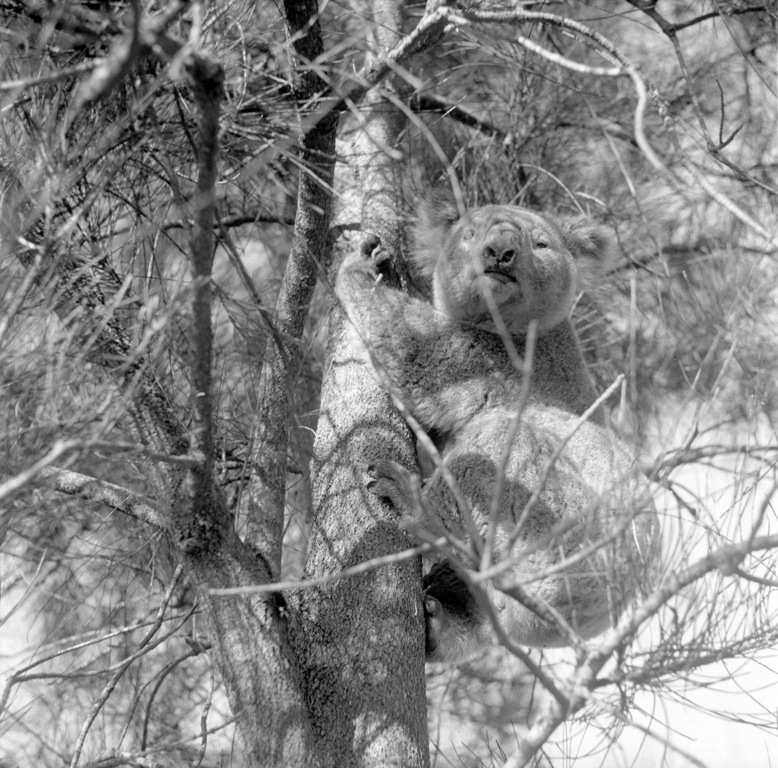Muogamarra Nature Reserve in Cowan celebrates 90 years: a few insights into The Vision of John Duncan Tipper, Founder
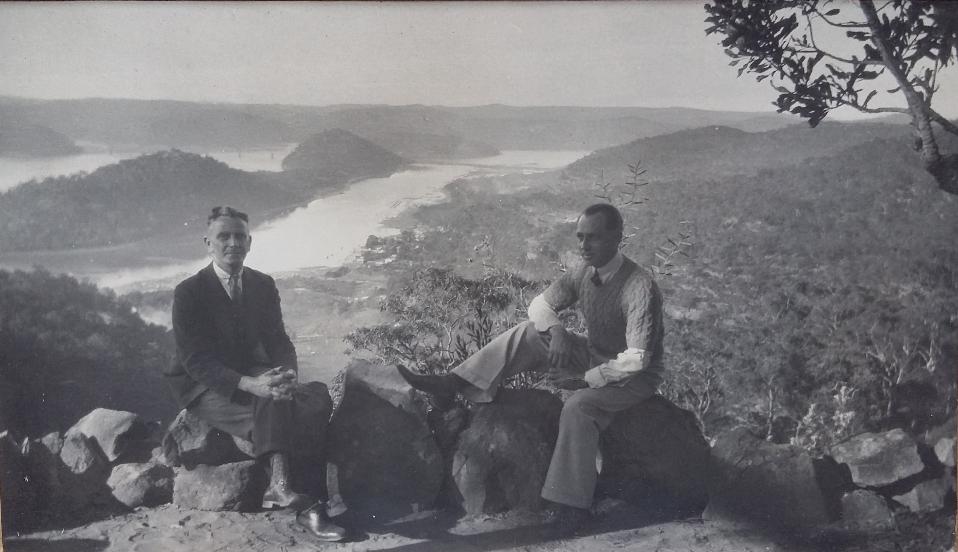
Muogamarra Nature Reserve in Sydney's northern outskirts is celebrating its 90th birthday by welcoming more than 4,700 nature enthusiasts during its 2024 Open Season.
The 'Muogamarra Sanctuary' was established in 1934 before being added to the state's National Park reserve in 1969.
The Sanctuary was the vision of John Duncan 'J.D.' Tipper, conservationist and electrical engineer. John was born August 4 1886 at West Maitland, New South Wales, the elder child of Edwin Tipper, an English-born printer and later a newspaper proprietor of the Maitland Ensign and journalist, and his native-born second wife Elizabeth, née McInnes. On his retirement, Edwin established apiaries at Willow Tree. John and his sister Elizabeth spent much of their childhood studying birds and animals in the Liverpool Ranges. He developed an appreciation of indigenous culture through his contact with Aborigines near the Barrington River.
Mr. Tipper belonged to the Wild Life Preservation Society of Australia, which was formed on the 19th May 1909 in the Royal Society's Hall, 5 Elizabeth Street, Sydney.
In 1928 he became founding president of the Rangers' League of New South Wales—a volunteer group dedicated to preserving natural bushland and preventing bushfires. Many Pittwater residents were early members of this league, and others were Honorary Rangers of our local reserves under the Fauna Protection Act 1948 and the Wild Flowers and Native Plants Protection Act 1927-1945, roles which persisted into the late 1950's.
THE RANGERS' LEAGUE.
(To the Editor).
Sir, — The Rangers' League, which was established for the purpose of giving practical service in its work covering the protection, and preservation of our unique and wonderful Australian Flora and Fauna and the other natural and special features of our country, has already made surprising progress.
Being the first organisation of its kind, the work of the League has been mainly pioneering. Much field work has. been accomplished valuable assistance has been rendered by the Government, and also 'by public and private organisations ; this . has helped in large measure to bring about the success 'which has been achieved. The team work of the members, the general increasing . interest, and the - praise and sympathy received from many sources, are very encouraging.
The' League, is under the control of a Council representative of its manifold, activities, such as ecology, botany, etc!, while the more immediate supervision is entrusted to an executive. The service rendered by the members is given in a purely honorary' capacity, and each member is expected to contribute assistance in some form; this service is supplemented, as far as possible, with available funds.
Several acts, of great interest to Rangers, are in course of amendment by Parliament,- and it is pleasing to note that suggestions by the League for the amendment of the Birds and Animals Protection Act have been accepted and included. The continued success of the League depends upon the individual and united effort of each of us. It is the duty of all Australians to do their utmost to protect and preserve our native birds, animals. plants and flowers, which are becoming more rare and even extinct. In our own interest and in that of our children, these must be regarded as an everlasting heritage to be handed down to future generations: As a means to that end, the -League is commended to you ~f or your generous support. Th secretary will be pleased, to receive inquiries from individual Rangers and all others who are interested. — Yours, etc., J. D, TIPPER, President. THE RANGERS' LEAGUE. (1930, June 21). Molong Express and Western District Advertiser (NSW : 1887 - 1954), p. 2. Retrieved from http://nla.gov.au/nla.news-article139979951
Instances of the breaking of these laws and prosecutions appear in the newspapers of he time. The accounts record thousands of wildlife species killed - most often to use their furred skin in some other way; for a coat, for a handbag - or simply for 'sport'. The flora fared no better and whole swathes of flowers and plants pulled out, by their roots, to be sold in markets for profit. The fine, which for decades stayed at £5 under these laws and their modified versions, was very little deterrent.
In outposts such as Pittwater still was then, with very little visible police presence on the ground, the neighbours noticing the strangers in their midst, and all being of one mind - to some the killing, to stop the desecration - was what saved lives and species:
BROKEN BAY BUSHLAND.
Rangers League's Work.
A field day organised by the Rangers' League over country to the south of Broken Bay revealed yesterday that there had been a number of offences against the laws for the protection of native flowers and animals. Native flowers which had been pulled up by the roots, said the president of the league, Mr. J. D. Tipper, Included an early variety of native rose. The country thereabout had been almost denuded of wild life. Organised hunting parties, which fired at anything they saw, were responsible, and a wallaby was now a rarity. About twenty names were taken of parties with protected wild flowers in their possession, with a view to prosecution. During the afternoon, added Mr. Tipper, one of the tyres of a car belonging to a ranger was slashed with a knife. BROKEN BAY BUSHLAND. (1931, August 3). The Sydney Morning Herald (NSW : 1842 - 1954), p. 10. Retrieved from http://nla.gov.au/nla.news-article16797764
SALE OF WARATAHS.
Flowerseller Fined.
Allegations were made against Leslie Chalker at the Central Summons Court yesterday that a large proportion of 2700 waratahs he was offering for sale at the City Markets on October 9 had been picked from Crown lands. The case was one in which William Riddle, honorary ranger, laid an information that Chalker had sold prohibited wildflowers.
Chalker's defence was that he had permits to pick wildflowers from the properties of Messrs. Campbell, Ladbury, and Kelsall, and he had obtained all the waratahs from them.
John Leslie Manson, honorary ranger, stated that he had examined the cut stalks on the three properties in question and had concluded that no more than 900 flowers could have been picked. John Duncan Tipper, honorary ranger, said he had visited the properties of Campbell and Ladbury where respondent said he had obtained 1500 waratahs, but he only found about 200 cut stalks.
Mr. Shepherd, S.M., fined Chalker £2, with costs, in default of 13 days' imprisonment.
Mr. Simpson appeared for the informant; and Mr. McCarthy for the respondent. SALE OF WARATAHS. (1931, November 13). The Sydney Morning Herald (NSW : 1842 - 1954), p. 7. Retrieved from http://nla.gov.au/nla.news-article16802132
A few other earlier insights:
HANG IN SNARES FOR ANTS AND CROWS!
Cruelty in Trapping Opossums
Should an open season be proclaimed for the slaughter of opossums? The Rangers' League has entered a hot protest against the proposal.
THE president of the league (Mr. J. D. Tipper) says that the declaration of an open season would mean that many of the 10,000 trappers in Queensland, and the 6000 in Victoria, would take the opportunity to clean out the remaining areas in this State, and that the opossums would soon be exterminated. Unemployed would not benefit, he says, because they could not afford the equipment, and would have little chance of competing with professional trappers.
Opossum
Opossum trapping is also cruel, claims Mr. Tipper. Often the animals are caught in snares which are forgotten by the trappers when leaving a district, and the opossums are left to dangle for a week or more, at the mercy of ants and crows, until they die after lingering pain and thirst. These and other conditions, all equally repugnant to modern ideas of how animals should be treated, take place under the license of an open season, Mr. Tipper added. The State Cabinet will probably consider the matter to-day.
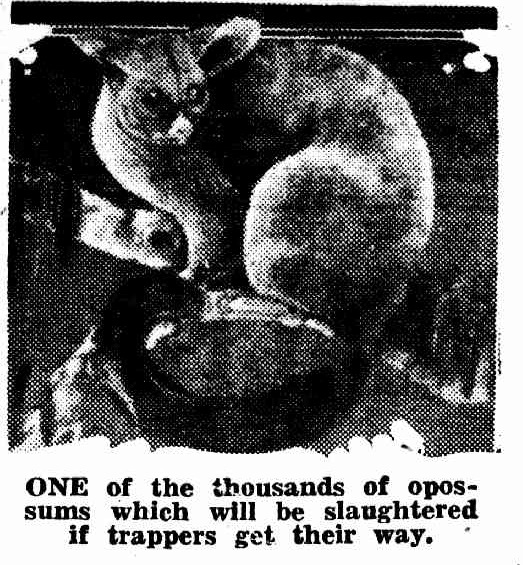
ONE of the thousands of opossums which will be slaughtered if trappers get their way. HANG IN SNARES FOR ANTS AND CROWS! (1930, June 16). Daily Pictorial (Sydney, NSW : 1930 - 1931), p. 5. Retrieved from http://nla.gov.au/nla.news-article246182148
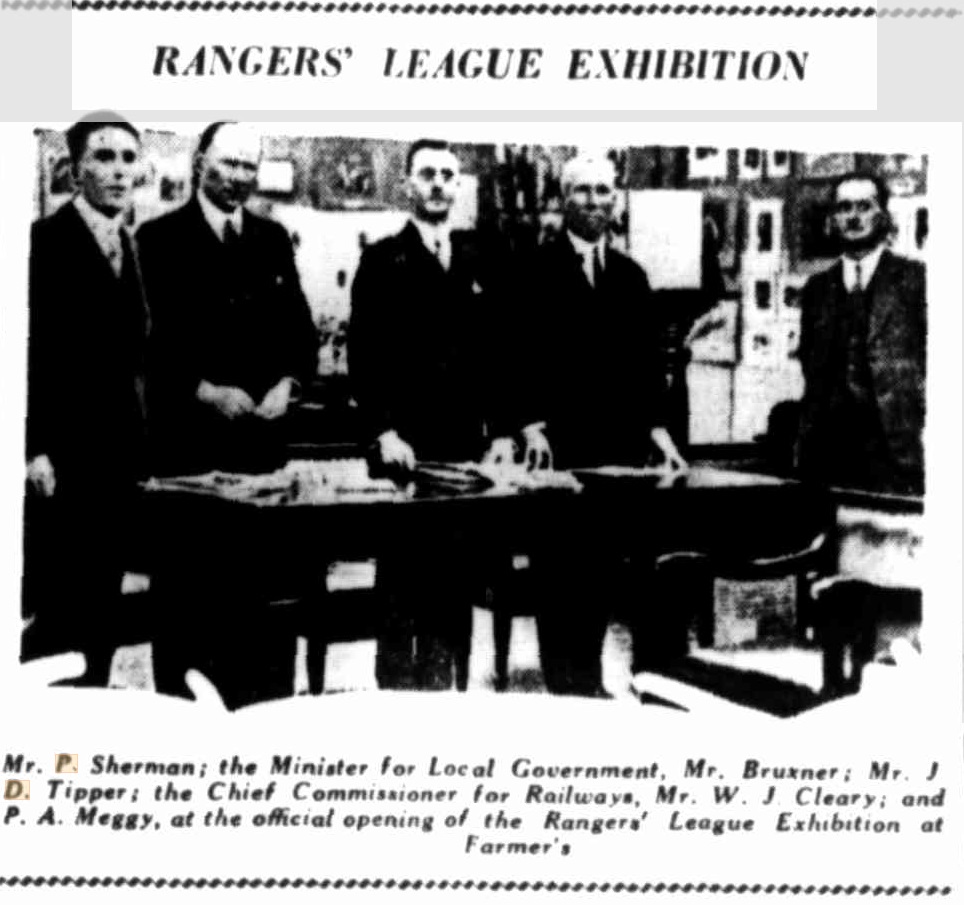
RANGERS' LEAGUE EXHIBITION (1930, September 17). Evening News (Sydney, NSW : 1869 - 1931), p. 5. Retrieved from http://nla.gov.au/nla.news-article118762839
QUAINT ROCK CARVINGS BY ABORIGINES IN THE GOSFORD DISTRICT.

These carvings, representing a Stingray, a Kangaroo in flight, and a Seal, were discovered by Mr. John D. Tipper, president of the Rangers League. An outing for motorists is being arranged by the League for Sunday, December 1, when these carvings and others will be inspected. QUAINT ROCK CARVINGS BY ABORIGINES IN THE GOSFORD DISTRICT. (1930, November 29). The Sydney Morning Herald (NSW : 1842 - 1954), p. 18. Retrieved from http://nla.gov.au/nla.news-article16734479
In 1932 J.D. helped to found the Australian Bushland Conservation Association, but his preservation ideals were constantly frustrated by continuing damage to Sydney's national parks, along with those who did the wrong thing locally:
BUSH LEAGUE AT ODDS
NO THANKS FOR MR. TIPPER
The action of Mr. J. D. Tipper in forming the Australian Bushland Conservation Association, while still Sydney Rangers' League president, provoked bitter criticism at the latter body last night. Mr. Arthur W. Atkinson (acting-president) threatened to resign if a motion put by a member "that a vote of thanks be sent to Mr. Tipper" was carried.
During an earlier discussion on the recent removal of Mr. Tipper from the chair a member left the meeting. "I didn't even know Mr. Tipper had formed this new association until I saw it in 'The Daily Telegraph;' " said the chairman (Mr R. Hazlewood). Mr. Atkinson said that Mr. Tipper had undermined the work of the League, of which he himself was a founder. The motion that Mr. Tipper be thanked was withdrawn. BUSH LEAGUE AT ODDS (1932, July 30). The Daily Telegraph (Sydney, NSW : 1931 - 1954), p. 7. Retrieved from http://nla.gov.au/nla.news-article246307885
DESTRUCTION OF BIRDS
Palm Beach Sanctuary.
A passing motorist made a prompt response on Sunday to an appeal by Australian Bushland Conversation Association for assistance in getting the police to put a stop to indiscriminate shooting of birds on the Palm Beach road. Mr. J. D. Tipper, honorary director of the association, said that several of the bullets went dangerously close to motor traffic. One bullet struck the ground In the midst of a party of children. When the police arrived, the members of the shooting party dispersed. Many complaints have been received of the shooting of birds in the locality, which is a proclaimed sanctuary. DESTRUCTION OF BIRDS. (1933, March 2). The Sydney Morning Herald (NSW : 1842 - 1954), p. 10. Retrieved from http://nla.gov.au/nla.news-article16981792
Our Bird Life
BUSHLAND ASSOCIATION'S THANKS.
Appreciation is expressed by the Australian Bushland Conservation Association to an unknown motorist for his prompt response to an appeal by an officer of the Association for police assistance near Palm Beach on Sunday 26th February, when ''sports'' were shooting birds on the main road.
Mr. John D. Tipper, Hon, director of the A.B.C.A., stated that bullets whizzed dangerously close in dense motor traffic: one shot was aimed right into a party of children playing on the beach.
Many complaints have been received by the Association in regard to bird shooting in the locality, which is a bird sanctuary. Recently cows owned by an agent of the Association were maimed because of his alleged reporting of shooting. The A.B.C.A. hopes that its action in locating the offenders will remove a public menace and give protection to bird life. Our Bird Life (1933, March 9). The Gosford Times and Wyong District Advocate (NSW : 1906 - 1954), p. 11. Retrieved from http://nla.gov.au/nla.news-article167863804
Our area, from at least Mona Vale northwards, has been a Bird Sanctuary since at least 1919 - others became Honorary Rangers protecting various local bush reserves and sanctuaries in succeeding generations - some are listed under References. From Warringah Shire Council Records:
His desire for a region protected from fires and illegal trafficking in native flowers led him in 1933 to obtain a lease of some 2000 acres (809 ha) around Muogamarra Ridge (overlooking the Hawkesbury River) from the Department of Lands:
Sydney, 6th April, 1934.
NOTIFICATION OF GRANTING OF SPECIAL LEASES.
IT is hereby notified that Special Leases of the lands specified in the annexed Schedule have been granted to the undermentioned persons.
The leases are subject to the provisions, of the Crown Lands Consolidation Act, 1913, and the Regulations there under, and to the special conditions, provisions, exceptions, covenants, and reservations set out at the foot of the Schedule.
Rent is subject to adjustment on survey as from the commencement of the next year ensuing.
Any amounts which have been paid in excess will be refunded upon application to the State Treasury. If not claimed, the amounts will be appropriated to future charges as they fall due.
Any amount required to complete payment of expenses and rent from the date of the commencement of lease to 31st December, 1934, must be paid by the lessee to the Crown Land Agent of the District or to the State Treasurer within one month from this date, otherwise the lease will be liable to forfeiture, and should forfeiture be declared all moneys lodged with the application will become forfeited to the Crown.
For the year 1935 and any subsequent year the rentals and instalments of survey fee (if any) must be paid during the month of December of the preceding year.
E. A. BUTTENSHAW, Minister for Lands.
Special Lease 1933-154, Metropolitan. John Duncan Tipper.—The lease shall be subject to subsections 1, 4, 6 to 20, 22a, and 23 of Regulation No. 106 (notified 27th November, 1931), and to following special conditions:—
(a) The term of the lease shall be divided into three periods, terminating on 31st December, 1938, 31st December, 1947, and 31st December, 1961, respectively, and the rental for each or any period after the first may be reappraised either upon reference by the Minister or at the request of the lessee made during the first six months erf any such period,
(b) The lessee shall carefully protect and preserve all aboriginal rock carvings on the land leased,
(c) The lease is limited to the surface and to a depth-of fifty (50) feet below the surface,
(d) The lessee shall erect 3 miles of substantial fencing on-the boundaries of the land leased within five years from the date of notification in the Government Gazette of the granting of the lease, not less than 1 mile of the fencing to be erected within one year from such date. Such fencing shall be maintained in efficient repair during the currency of the lease. NOTIFICATION OF GRANTING OF SPECIAL LEASES. (1934, April 6). Government Gazette of the State of New South Wales (Sydney, NSW : 1901 - 2001), p. 1488. Retrieved from http://nla.gov.au/nla.news-article223058757
The reserve was established in 1934 and opened to the public in the following year. Called the Muogamarra Sanctuary, its name came from the Awabakal Aboriginal dialect and meant 'preserve for the future'.
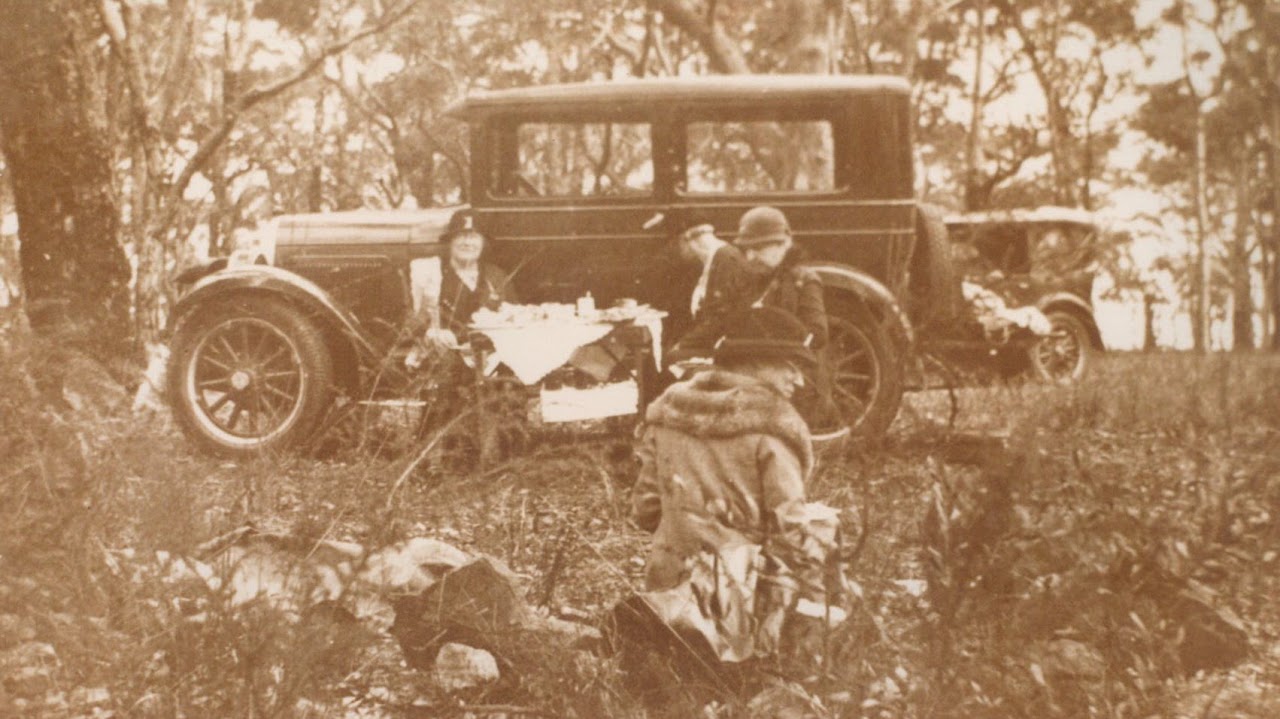
Picnic at Muogamarra in 1934 from J. D. Tippers Photo Collection. courtesy Mitchell Library, State Library of New South Wales
Although this report gets J.D.'s first name wrong, it does provide an insight into the shift in thinking at all levels that persisted from 1881's Bird's Protection Act on:
DEVILS
THEY DIDN'T BITE
LADY HORE-RUTHVEN VISITS SANCTUARY
ALTHOUGH she was unable to see any of the rock wallabies, kookaburras, or black magpies which she had been told about, Lady Hore-Ruthven was introduced to mountain devils when she visited Muogamarra Research Station and sanctuary for Australian flora and fauna at Cowan to-day. She was pleased to learn that they did not bite.
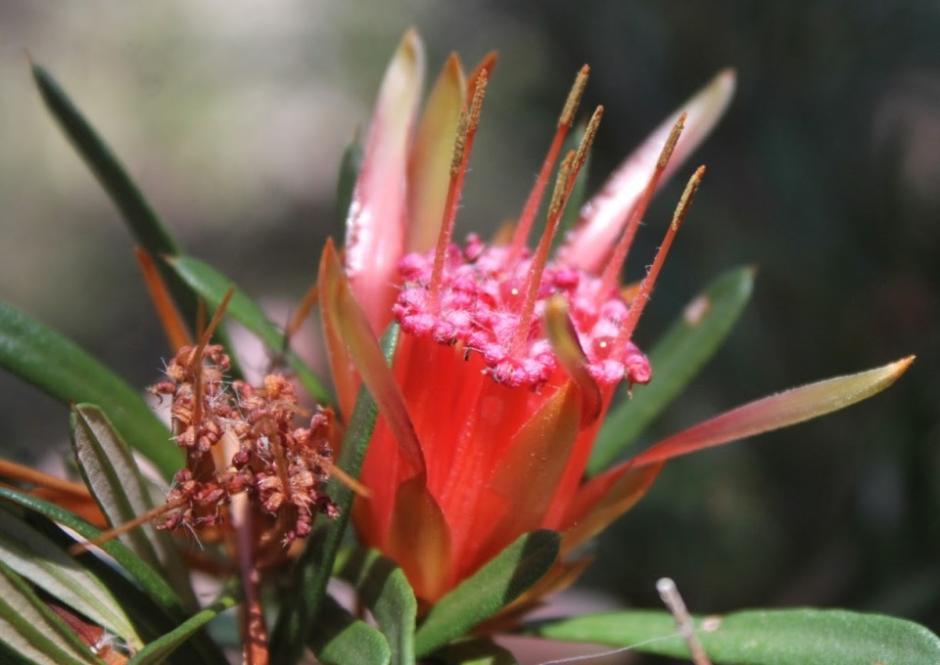
Mountain Devil or Honey Flower(Lambertia formosa) **
Lady Hore-Ruthven walked more than a mile in the hope of seeing one of the famous Lyre-birds, but they, too, were apparently In hiding, as were the audacious little honey-eaters, which are so keen on swooping on a man's head or woollen jumper in search of nesting material. A light though fickle breeze was said to have kept the thousands of native birds away from their familiar haunts.
Lady Hore-Ruthven was amazed, however, to see the pictorial story of the early aborigines in the symbolic markings on the rocks, to saunter over old-time native meeting-places and ceremonial plots, and to remark the delight of natural bush fragrance from hundreds of beautiful protected plants.
"Dirty Work"
Examining native Implements, Lady Hore-Ruthven was told by Mr. Laurence J. Tipper of "an easier way of despatch In the older day of the district." The white man generously invited the natives over to his dwelling for Christmas dinner of roast bullock and then poisoned all his guests!
"Extremely dirty work," observed Lady Hore-Ruthven, with a wry, humorous little smile.
Apart from the great variety of plants and trees, the general lay-out of the sanctuary impressed her Excellency, who was accompanied by Mrs. Anderson, wife of Major-General Anderson. The view of the Hawkesbury from the sanctuary lookout was declared to be the third best view in the world. DEVILS (1935, August 1). The Sun (Sydney, NSW : 1910 - 1954), p. 21 (LATE FINAL EXTRA). Retrieved from http://nla.gov.au/nla.news-article231277650
Laurence James Tipper was the name of J D Tipper's son, born 1914.
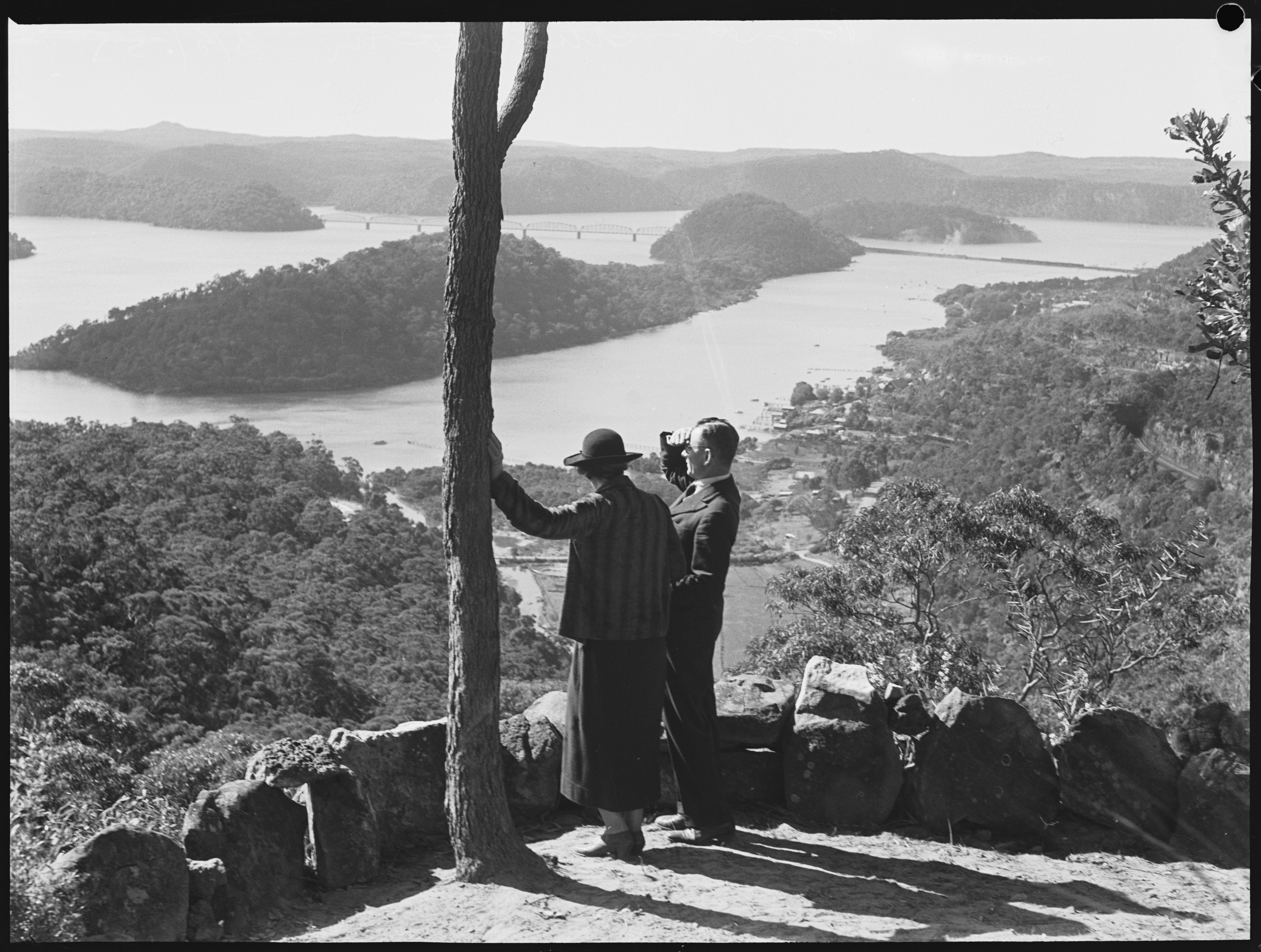
Bird Sanctuary (Lady Hore Ruthven). J. D. Tipper, Prop., August 1935. Lady Hore Ruthven was NSW Governor’s wife Reference: State Library NSW (Created before 1955). Bird Sanctuary (Lady Hore Ruthven). J. D. Tipper, Prop., August 1935 . Retrieved from https://collection.sl.nsw.gov.au/record/1xqG6x6Y/2lMEwmvBJrkD0.
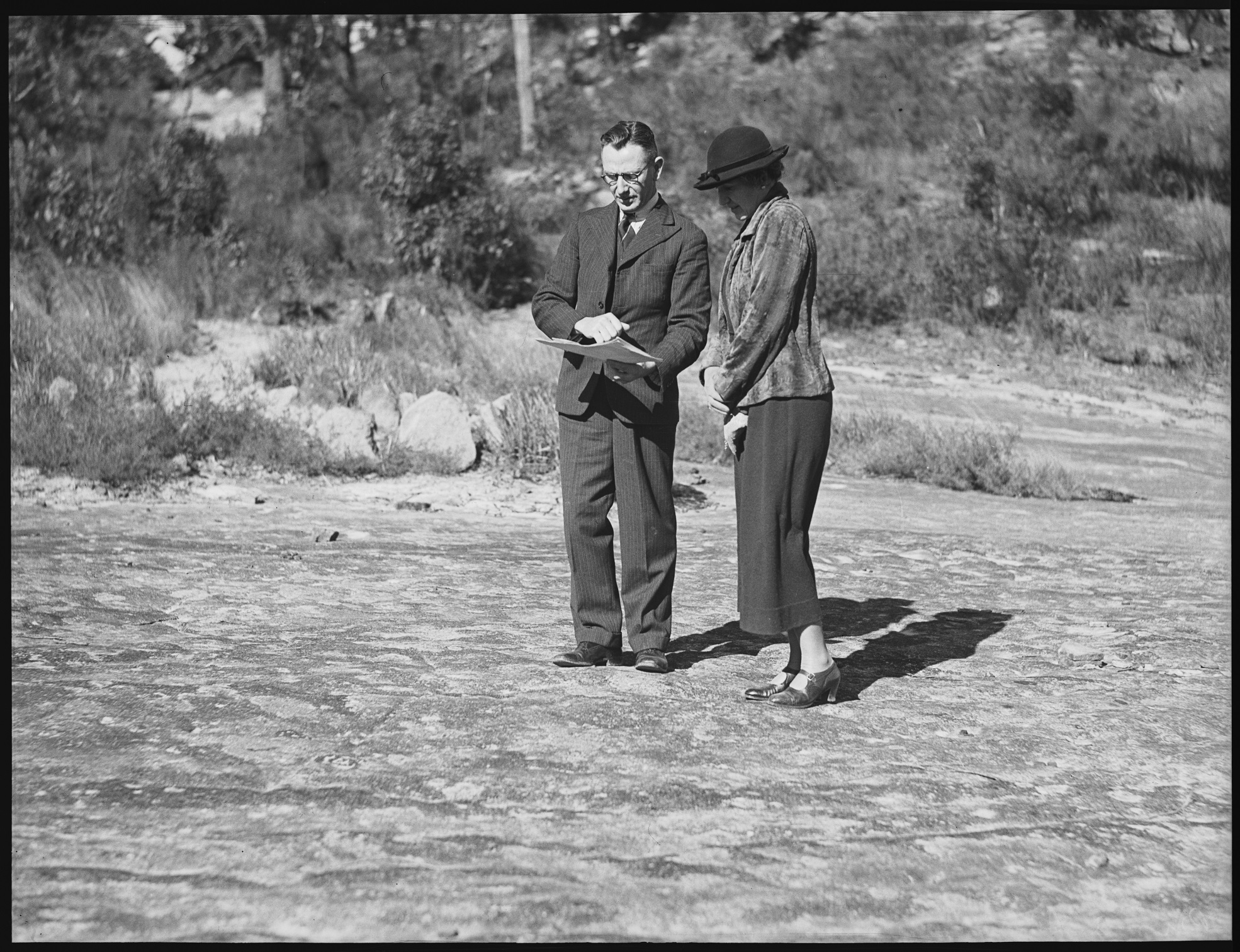
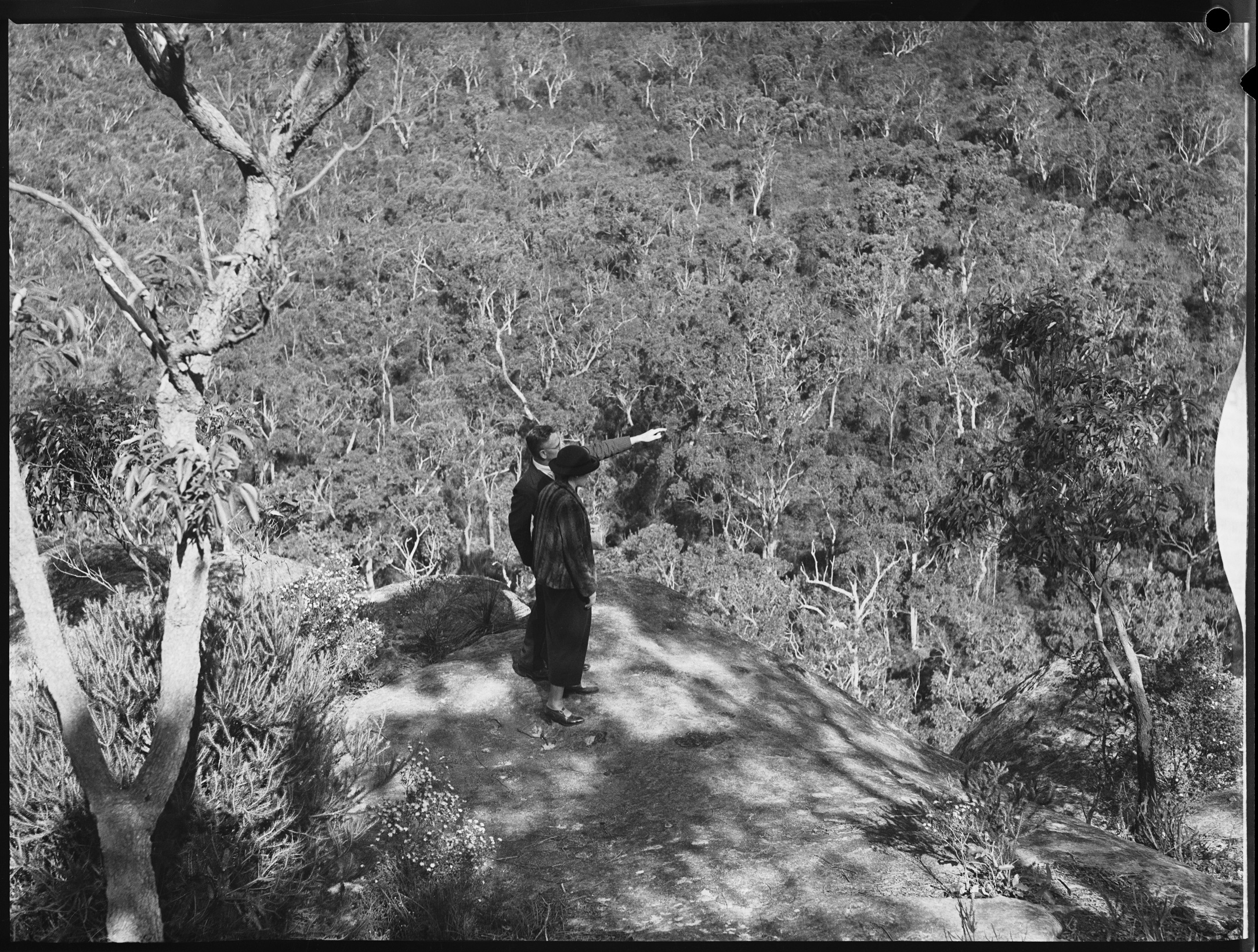
** Mountain Devil or Honey Flower(Lambertia formosa) was first described in 1798 by English botanist James Edward Smith, it is the type species of the small genus Lambertia. It is generally found in heathland or open forest, growing in sandstone-based soils. It grows as a multistemmed shrub to around 2 m (7 ft) with a woody base known as a lignotuber, from which it regrows after bushfire. It has stiff narrow leaves, and the pink to red flowerheads, made up of seven individual tubular flowers. It gains its common name from the horned woody follicles, which were used to make small devil-figures and from the fruit's resemblance to a devil's head.
The flowers hold profuse amounts of nectar and are pollinated by honeyeaters. Although L. formosa is uncommon in cultivation, it is straightforward to grow in soils with good drainage and a partly shaded to sunny aspect. It is readily propagated by seed. Unlike all other members of the genus Lambertia, L. formosa is greatly resistant to the soil pathogen Phytophthora cinnamomi.
Specimens of Lambertia formosa were collected by botanists Joseph Banks and Daniel Solander during Lieutenant James Cook's landing at Botany Bay between April and May in 1770. These are thought to have been obtained from vegetation currently known as the Eastern Suburbs Banksia Scrub that occurs in sandy areas near present-day La Perouse. The shrub was first described in 1798 by English botanist James Edward Smith who concurrently erected the new genus Lambertia, the name honouring English botanist Aylmer Bourke Lambert. The specific name formosa is the Latin adjective for 'handsome'. English plantsman Henry Charles Andrews wrote in 1799, "Of all the plants yet introduced from New Holland, that have hitherto flowered with us, this unquestionably takes the lead for beauty, considering the plant altogether", although his countryman Joseph Knight in his 1809 work On the cultivation of the plants belonging to the natural order of Proteeae added that the species name "applies only to the flowers, the foliage being generally of a sickly hue". French botanist Michel Gandoger described specimens collected at Hornsby and Port Jackson as Lambertia proxima, and material sent to him by plant collector Charles Walter as L. barbata in 1919; these turned out to be L. formosa.
The common name "honey flower" is derived from the flowers which produce a clear nectar in large quantities. This was a source of nourishment for Aborigines and, following European colonisation, explorers, escaped convicts and children were recorded sucking the flowers. Explorer Ludwig Leichhardt wrote that "often when I've been tired and thirsty, I've bitten off the base of a tuft of Lambertia formosa flowers to suck the delightfully sweet honey out of them". Headaches and nausea have been reported from ingesting large quantities of the fluid, though it is not known to contain a toxic substance.
The species was the subject of an illustration by Sydney Parkinson, artist on HM Bark Endeavour's voyage to the Pacific from 1769 to 1771. A colour botanical engraving based on Parkinson's work is part of Banks' Florilegium. First Fleet midshipman and artist George Raper depicted the species in two works: an untitled watercolour study (c. 1788) and Bird Of Point Jackson (1789). Writer and illustrator George Collingridge incorporated the flower in several of his designs and unsuccessfully championed it as the floral emblem of Australia.
A 1936 excursion describes:
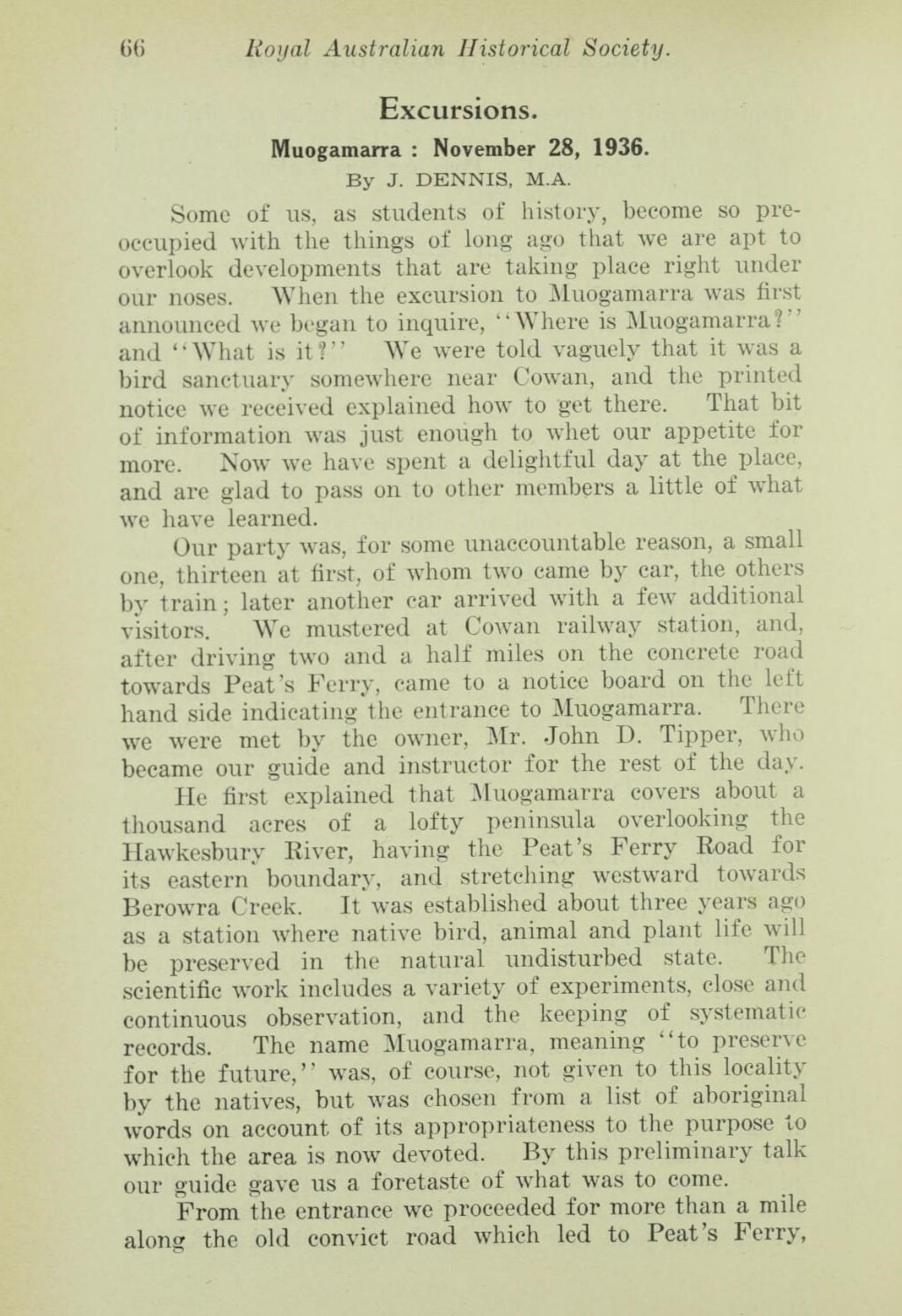
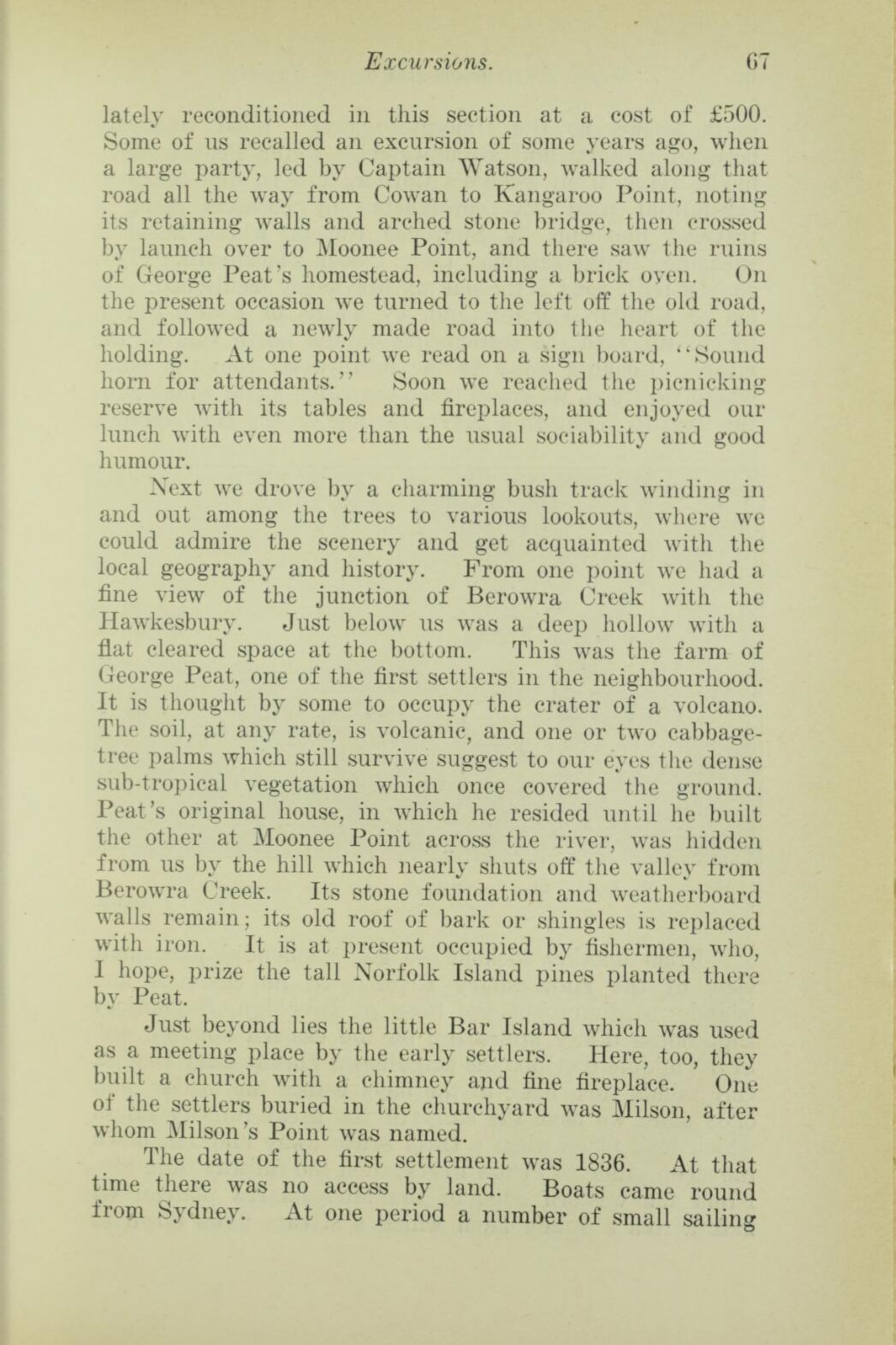
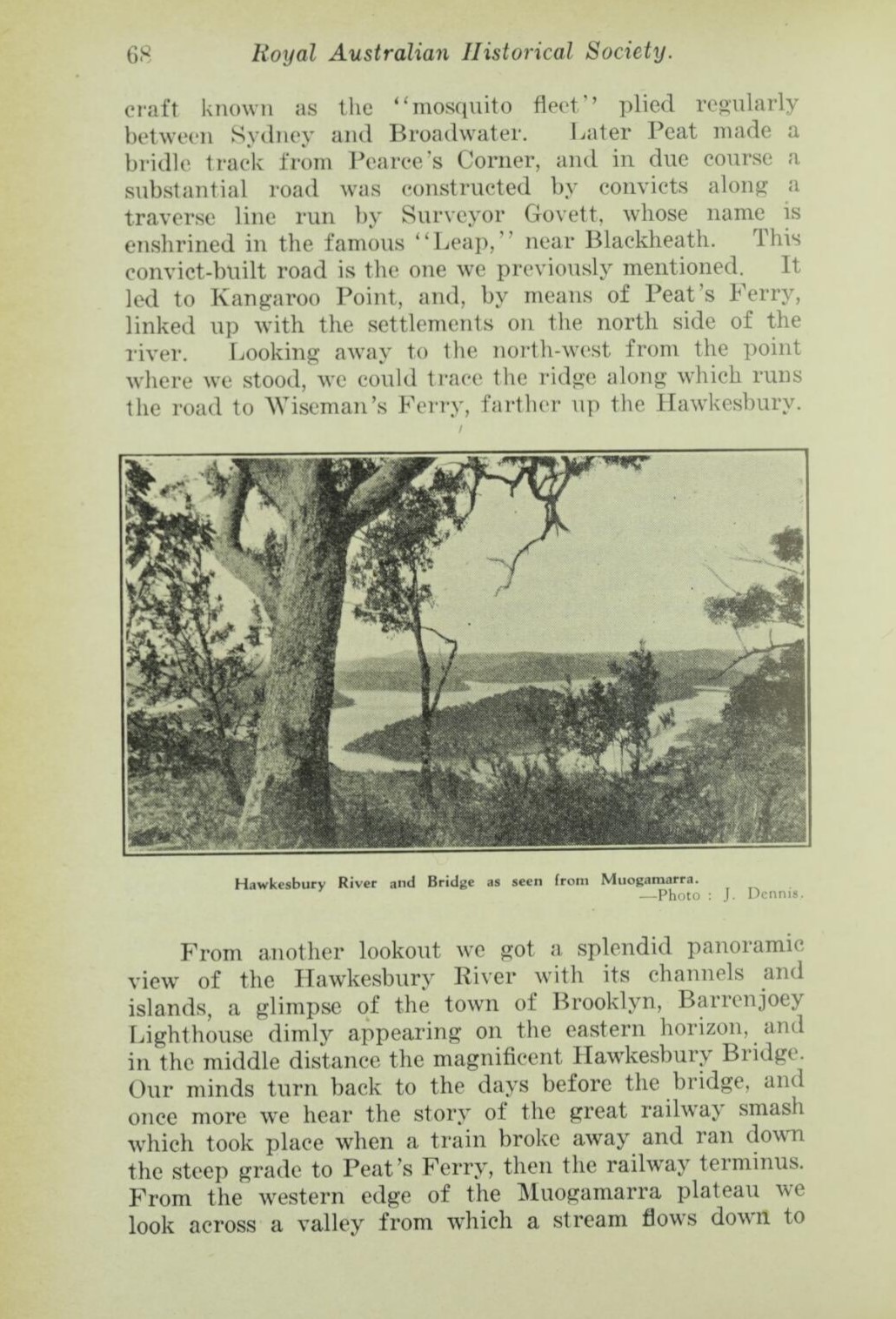

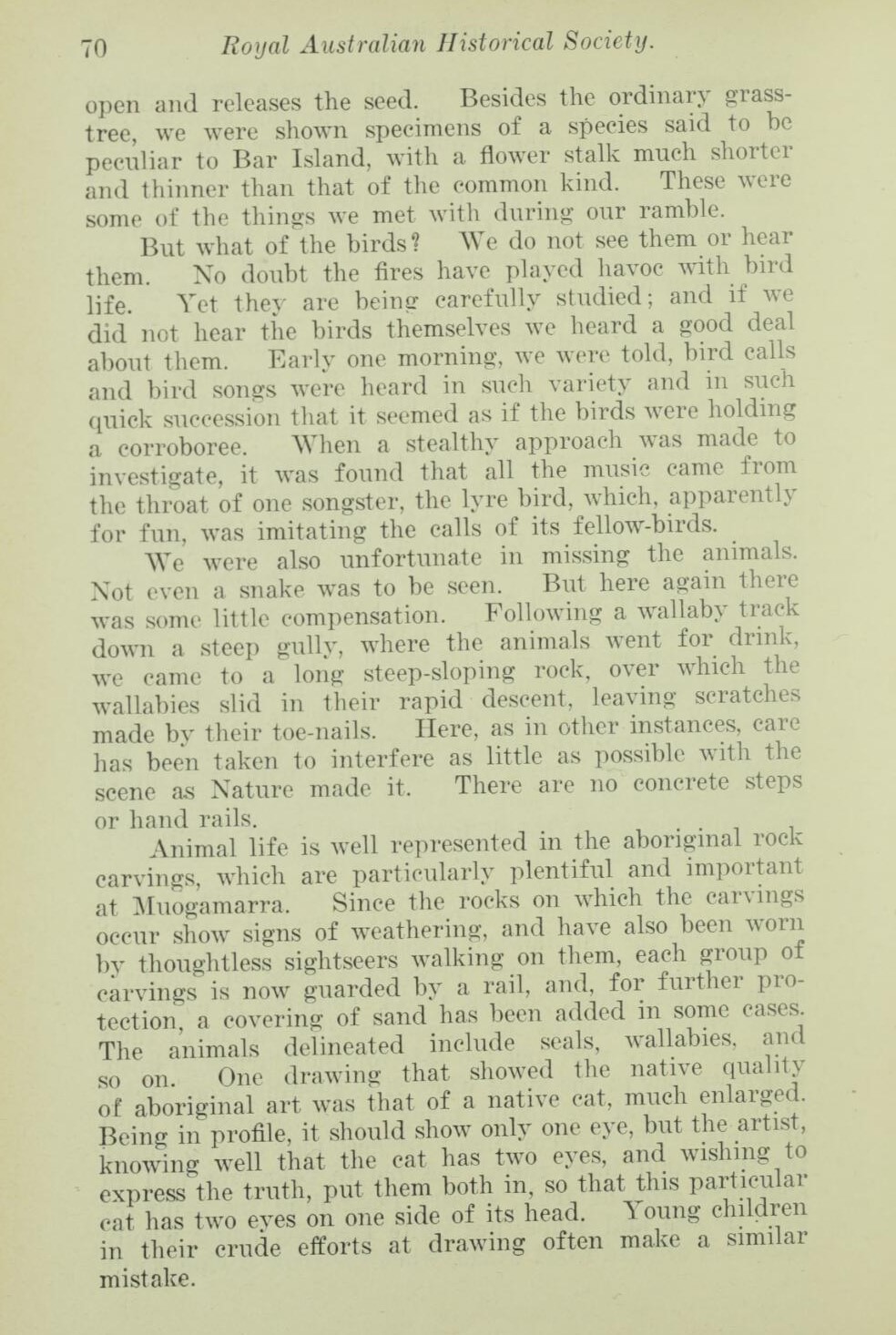
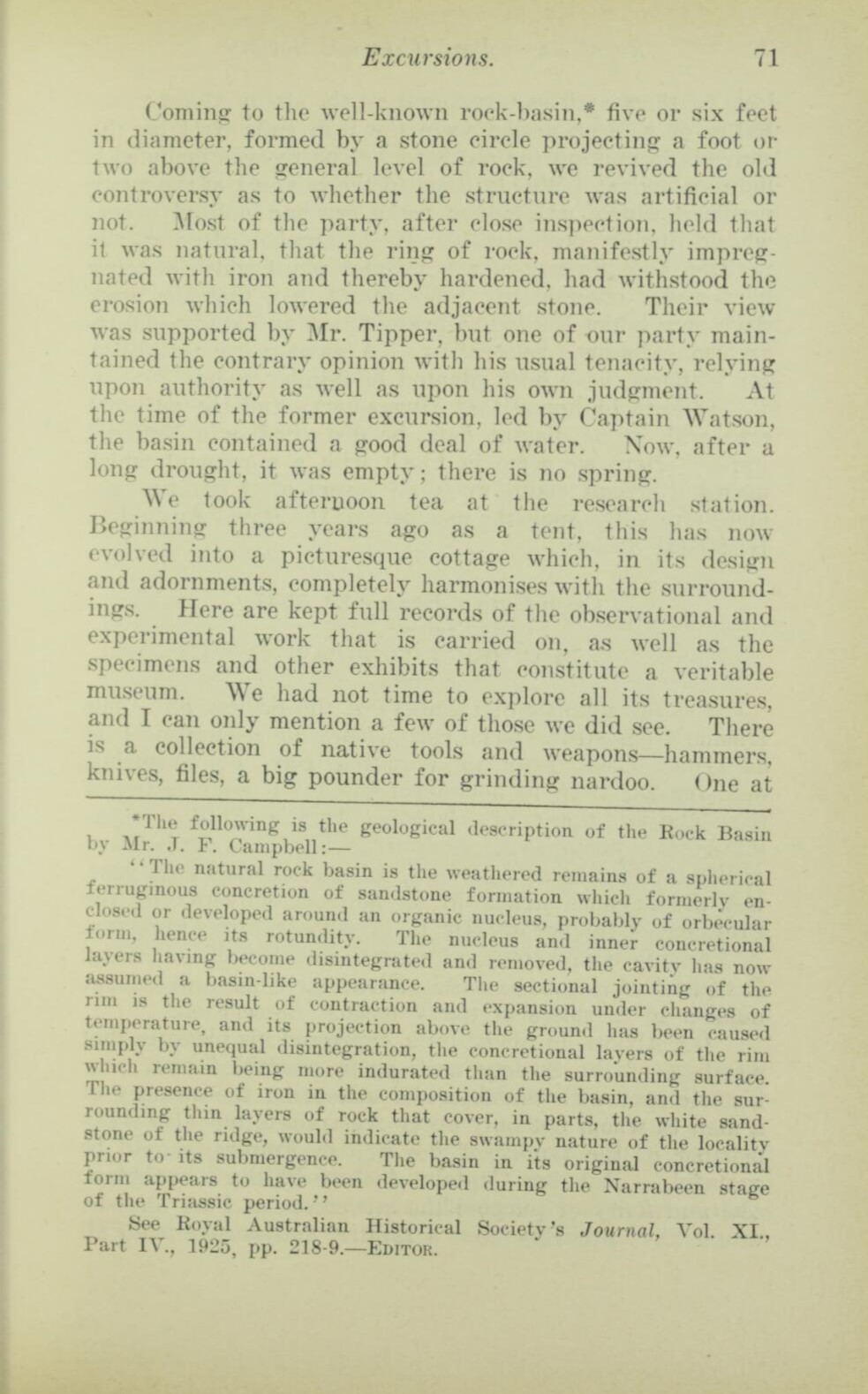

Excursions. Muogamarra: November 28, 1936. (1 February 1937) - Royal Australian Historical Society - Appears In ' Journal and proceedings, no.Vol 23 Part 1, 1937-02-01, p.68 (ISSN: 1325-9261)'
One from the following year:
CAMPFIRE AT SANCTUARY
Governor Invited To Attend
The Governor, Lord Wakehurst, several overseas visitors, and many Sydney people, have been invited to a moonlight forest camp fire at Muo-gamarra Sanctuary, Cowan, on May 22.
Mr. John D. Tipper, who controls the sanctuary, which is his property, expects that about 400 people will be present. The camp fire is set down for 7 p.m.. but an inspection of the property will be held in the afternoon.
At Muogamarra (an aboriginal word meaning "to preserve for the future"), are native flowers, birds and animals, and fine scenery. Mr. Tipper said to-day that the camp fire would augment funds to combat fires in the coming summer. : "Fires last year did great damage," he added. CAMPFIRE AT SANCTUARY (1937, May 6). The Sun (Sydney, NSW : 1910 - 1954), p. 42 (LATE FINAL EXTRA). Retrieved from http://nla.gov.au/nla.news-article229410388
MUOGAMARRA SANCTUARY.
A special afternoon inspection of the Muogamarra sanctuary at Cowan will be held to-morrow, and will be followed by a moon-light camp-fire concert. The area now covered by Muogamarra was a grant from the Government to Mr. J. D. Tipper, to assist in the conservation of native bird, animal, and plant life. With the fine views to be obtained from its high situation of the Hawkesbury River, and its interesting tree and plant life, the Australian Bushland Conservation Association is endeavouring to make the area one of the "show windows" of Australia. MUOGAMARRA SANCTUARY. (1937, December 17). The Sydney Morning Herald (NSW : 1842 - 1954), p. 8. Retrieved from http://nla.gov.au/nla.news-article17438824
Mr. Tipper worked tirelessly to protect the native flora: he set up a volunteer bush fire brigade and, eventually, an environmental study centre and museum. Public access was limited during the six-week wildflower blooming season from mid-August to the end of September.
A Spring 1946 article in The Australian Women's Weekly underlines the importance of the Sanctuary:
.jpg?timestamp=1725664456626)
.jpg?timestamp=1725664484621)
.jpg?timestamp=1725664529045)
Sanctuary saves wildflowers from extinction (1946, September 28). The Australian Women's Weekly (1933 - 1982), p. 11. Retrieved from http://nla.gov.au/nla.news-article47505042
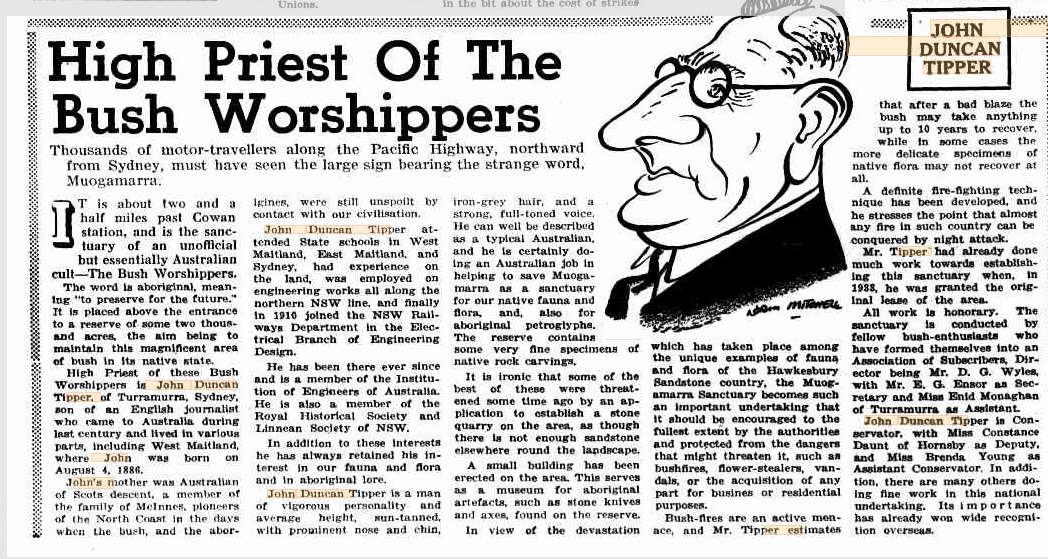
High Priest Of The Bush Worshippers (1947, May 24). Smith's Weekly (Sydney, NSW : 1919 - 1950), p. 15. Retrieved from http://nla.gov.au/nla.news-article234631294
Organisations keen to turn part of the sanctuary over for human use or profit were not the only humans Tipper and his supporter volunteers had to battle against to save the wildlife and wildflowers:
Sanctuary Not To Be Disturbed
SYDNEY.— Application for special leave for permission to quarry rock in Muogamarra Sanctuary at Cowan on the Hawkesbury River would not be granted, said the Minister for Lands (Mr. Sheahan) today.
'After inspecting the sanctuary last Friday I am of the opinion that it must be protected by every possible means and saved from disturbance as much as possible,' he said. 'Quarrying or use for any other purpose of the kind within the sanctuary should be opposed in the public interest.
Mr. Sheahan's permission has to be given before a special lease is granted. The sanctuary, covering an area of about 2000 acres of the original Hawkesbury forest, was established to preserve bird, animal and wild flower life.
' -The conservator of the sanctuary r (Mr. John D. Tipper) said today: 'The applications for permission to quarry rock in the sanctuary caused consternation among lovers of wild life.' Sanctuary Not To Be Disturbed (1947, September 1). The Newcastle Sun (NSW : 1918 - 1954), p. 2. Retrieved from http://nla.gov.au/nla.news-article157898664
The then Minister for Lands, William Francis Sheahan (1895-1975), had been a member of the Australian Labor Party since age 16.
Mr. Sheahan had unsuccessfully contested the Legislative Assembly seat of Petersham in 1935 and 1938. In 1941, with Petersham abolished due to a redistribution, he decided to contest Yass where he claimed to have more than two thousand relations. He won the seat (renamed Burrinjuck in 1950) and held it for the rest of his career.
He was appointed secretary for lands on 19 May 1947; in this capacity he made an important contribution to the success of soldier settlement. On 30 June 1950 he became minister for transport, a difficult portfolio which he tackled with energy and vision; his term in office, however, was not an unqualified success, due in part to the growing problem of public-transport deficits.
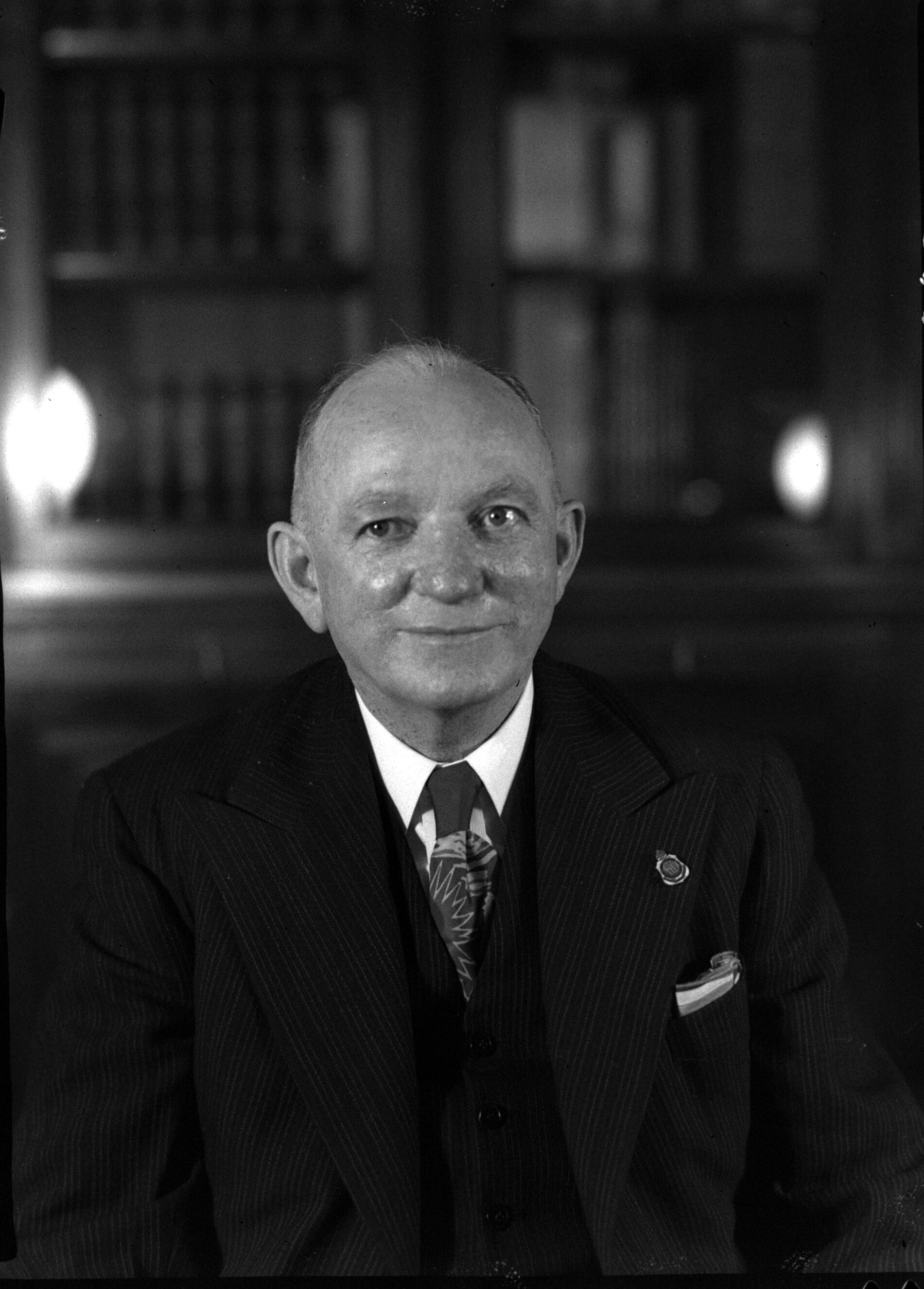
William Francis Sheahan (1895-1975), by unknown photographer, 1950, courtesy State Library of New South Wales and NSW State Records and Archives, Item: FL3816074
Given the attorney-generalship by J. J. Cahill on 23 February 1953 and appointed Q.C. that year, he carried through a programme of law reform, including the abolition (1955) of the death penalty for all offences except treason and piracy. From 15 March 1956 to 13 May 1965 he served as minister for health. Once again, he implemented major changes, such as the Mental Health Act (1958) and the Clean Air Act (1961). [2.]
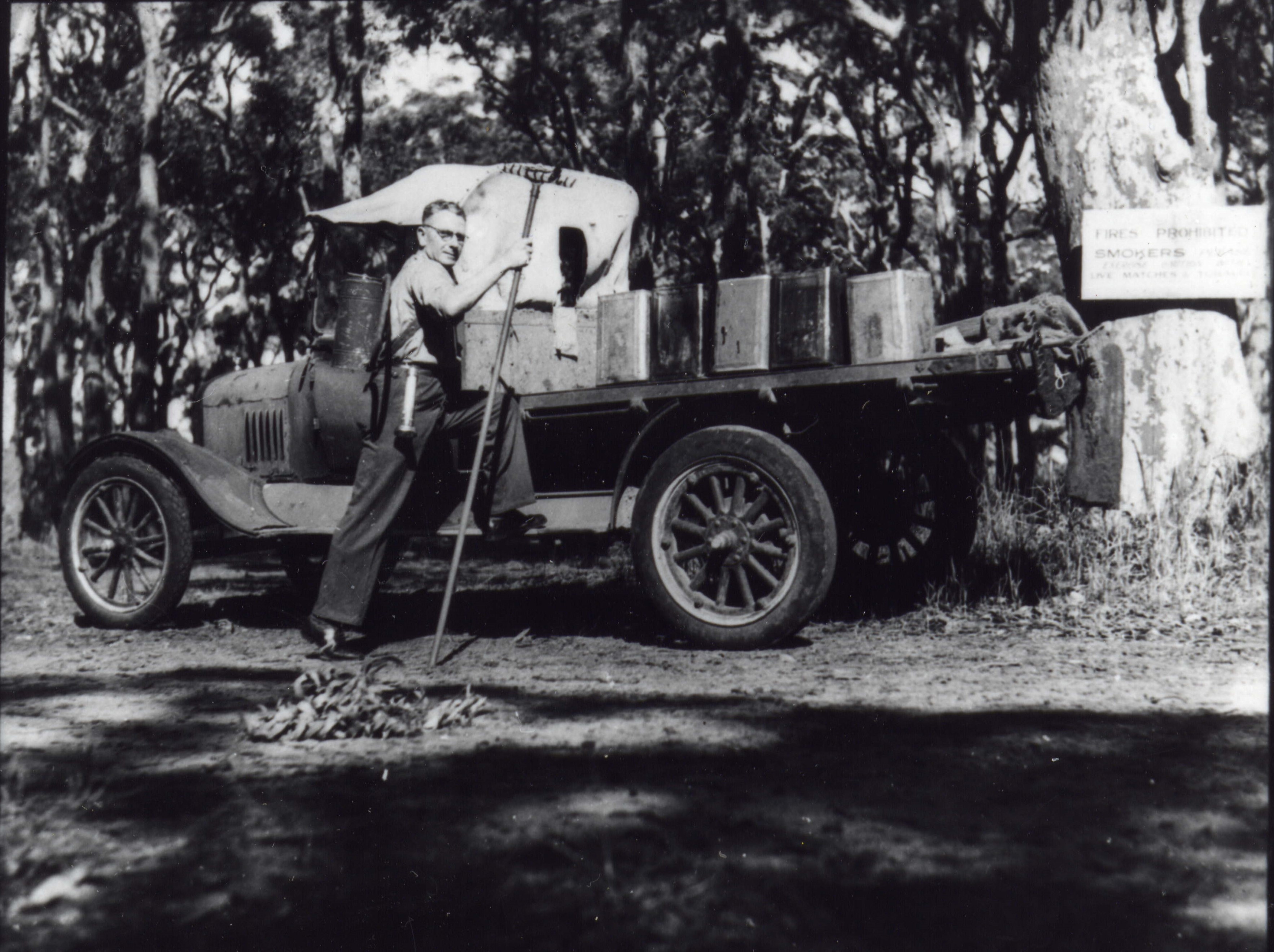
J.D. and his work truck, 1930's. Photo courtesy Gibberagong Environmental Education Centre image collection. Original Source and Date Unknown. © State of New South Wales (Department of Education and Department of Environment and Heritage)
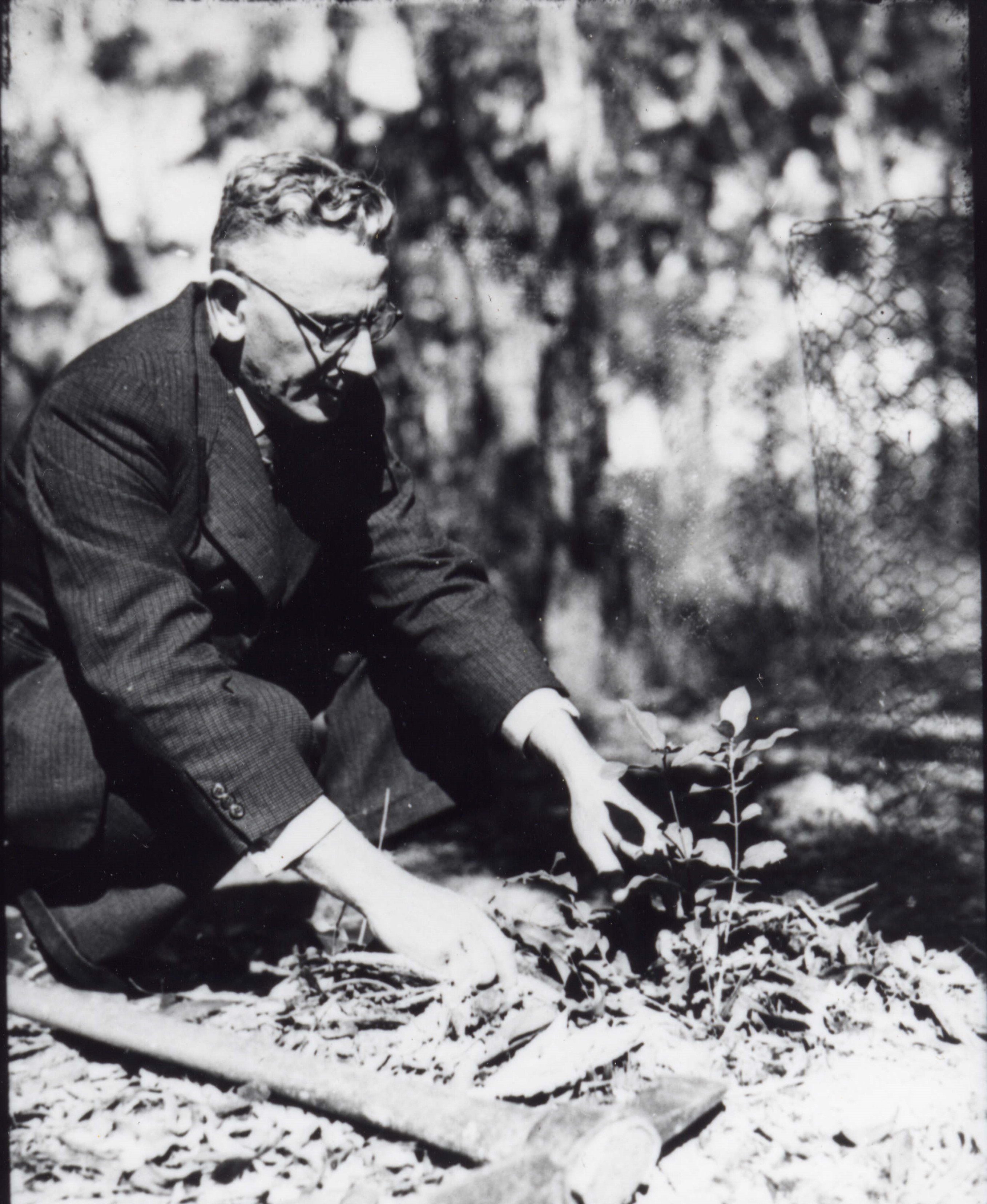
J.D. planting. Photo courtesy Gibberagong Environmental Education Centre image collection. Original Source and Date Unknown. © State of New South Wales (Department of Education and Department of Environment and Heritage)
Mr. Tipper continued in this work, although constant reference to those who wanted to destroy the wildlife and wildflowers for their own means and reasons recurs in newspaper reports on the Sanctuary - another example:
Making Permanent A Wild-life Sanctuary
MR. JOHN D. TIPPER, of Turramurra, lessee of the Muogamarra Sanctuary; 2,000 acres of wild natural bushland among the ridges and gullies of the Hawkesbury River country-is trying to preserve the sanctuary for all time as a national asset.
He has applied to the Department of Lands to convert permissive occupancies covering more than half of the area into long term leases.
Long-term leases, according to many people and organisations who subscribe towards the upkeep of the sanctuary, would put an end to attempts to open up parts of the area for sandstone quarrying in areas containing valuable aboriginal rock carvings.
Muogamarra (pronounced Moo-oga-marra) is an aboriginal word meaning "preserve for the future." The sanctuary is one of the best preserved remaining examples of the Sydney bushland.
The sanctuary to-day shelters much of our rare wild-life. Lyre-birds, koalas and rare opossums, white boronia, waratah, and the dis-appearing native rose, have been carefully fostered and preserved as far as possible from bushfire and vandal.
Native Relics
Muogamarra owes its existence principally to the foresight of Mr. Tipper, who in 1933 obtained from the State Government a long-term lease of about 600 acres west of the Northern Highway not far from Peat's Ferry. In later years 1,400 more acres have been added to the sanctuary under permissive occupancy titles. Some of this land fronted the highway and acted as a buffer against bushfires reaching the heart land of the sanctuary.
With many helpers he has worked for more than 20 years to save its ethnological and natural treasures without exploiting them. Muoga-marra to-day is no picnic ground as are some national reserves. It has become an educational institution to which come students of our native flora and fauna, and of aboriginal relics preserved in the state in which the aborigines knew them.
One of the outstanding achievements in the sanctuary has been the successful cultivation of the now almost extinct native rose. An area devoted to these plants represents 13 years of patient and expert care. Many other plants are the subject of scientific cultivation, and to pre-vent damage to them visitors to the ' area are not allowed to leave the pathways.
The sanctuary is a private venture, but is not conducted for profit. It numbers among its subscribers learned societies, schools, and individuals in Britain and in the United States.
Mr. Tipper says that his self-imposed task of conserving the area has meant the overcoming of great public apathy and indifference towards our flora and fauna. It has also meant a struggle to prevent the exploitation of the natural resources of the area.
In recent years, he says, there has been an increasing public concern at the loss of important national assets, and Governments have shown interest in efforts to preserve natural reservations. For that reason he and the Muogamarra subscribers hope that his tenure of the land will be secured by long lease. Making Permanent A Wild-life Sanctuary (1950, March 14). The Sydney Morning Herald (NSW : 1842 - 1954), p. 2. Retrieved from http://nla.gov.au/nla.news-article18151842
In 1953 Tipper surrendered his lease and the Sanctuary became a Reserve:
Sydney, 12th June, 1953.
WITHDRAWAL FROM SPECIAL LEASE FOR PROMOTION OF THE STUDY AND CONSERVATION OF NATIVE FLORA AND FAUNA.
IT is hereby notified, for public information, that in pursuance of the conditions attached to Special Lease 33-154, Metropolitan, held by J. D. Tipper, the Crown lands hereunder described are hereby withdrawn from that Special Lease for Promotion of the Study and Conservation of Native Flora and Fauna.
F. H. HAWKINS, Minister for Lands.
County of Cumberland, parish of Cowan, about 700 acres, the whole, being portion 260. C. 4,039-2,030. P. 53-3,340. WITHDRAWAL FROM SPECIAL LEASE FOR PROMOTION OF THE STUDY AND CONSERVATION OF NATIVE FLORA AND FAUNA. (1953, June 12). Government Gazette of the State of New South Wales (Sydney, NSW : 1901 - 2001), p. 1934. Retrieved from http://nla.gov.au/nla.news-article220015522
Muogamarra Sanctuary
Now A Reserve
The State Government has declared Muogamarra sanctuary a special reserve where research workers and others may study Australian animals, birds and plants.
Muogamarra - an aboriginal word meaning "preserve for the future" - is on the Hawkesbury River, near Cowan. It comprises more than 2,000 acres of bush-land.
The area was set aside as a sanctuary 20 years ago. Mr. John D. Tipper has preserved it in its primitive state and protected the native fauna and flora. The reserve will in future be controlled by a trust of nine members, with Mr. Tipper as chairman and conservator. Members include representatives of several conservation societies and the Departments of Lands and Local Government.
Muogamarra will be open to visitors for a small charge when the bush flowers are in bloom, but will not be available to hikers, picnickers or campers. Muogamarra Sanctuary Now A Reserve (1953, June 26). The Sydney Morning Herald (NSW : 1842 - 1954), p. 2. Retrieved from http://nla.gov.au/nla.news-article27525935
Fight To Preserve Bush Sanctuary
By KANANGRA
FIRE has been the worst A enemy in the 20 years' struggle to preserve the 2,000 acres of Muogamarra bushland sanctuary on the Hawkesbury River which will be opened to the public to-day.
Twice at least its forested hills and gullies have been swept by fire, causing serious losses of native wild-life, and more than 100 outbreaks have been fought within the area since 1933.
Muogamarra is 29 miles north by road from Sydney. When I visited the sanctuary a few days ago, its founder, Mr. J. D. Tipper, told me of the increasing vigilance that had been necessary to preserve Muogamarra not only from fire but also from vandals and from those who sought to filch portions of the land.
Strict Discipline
Showing me a well-equipped fire-control hut, Mr. Tipper said: "Every fire we have fought here started outside our boundaries, apparently as a result of carelessness. That's one important reason why we have kept Muogamarra closed to the public through the summer.
"We've had to forbid visitors using matches, smoking or lighting cooking fires without permission. However, a large open fire-place, hot water and other amenities are provided at the central car-parking area beside our head-quarters' office."
Muogamarra has made one of its rare appearances in the news by having been reserved recently by the State Government as a sanctuary for native fauna and flora. Thus its status has been changed from that of one of Australia's few private sanctuaries to that of a national preserve.
But, with Mr. Tipper still in charge it seems clear that the new step will not affect the character or purpose of Muogamarra.
Because of the rugged terrain, the sanctuary can be entered by vehicles only through the double gates on the western side of Pacific Highway, about two and a half miles north of Cowan railway station. .Except on certain week-end visiting days, this entrance is always kept padlocked.
A bush road leads one and a half miles into the heart of Muogamarra, where the headquarters' office stands on a level ridge 700 feet above sea-level.
There, from its several look-outs, are revealed some of the finest panoramas of the Hawkesbury River country.
The wildflowers now unfolding include boronia, native roses, flannel flowers, wattles, and a multitude of other native plants which favour this sandstone landscape. Waratahs will be in bloom there about mid-August.
Muogamarra's new public inspection season will extend to September 27. Visiting days are week-ends only, and Mr. Tipper says a small charge will be made.
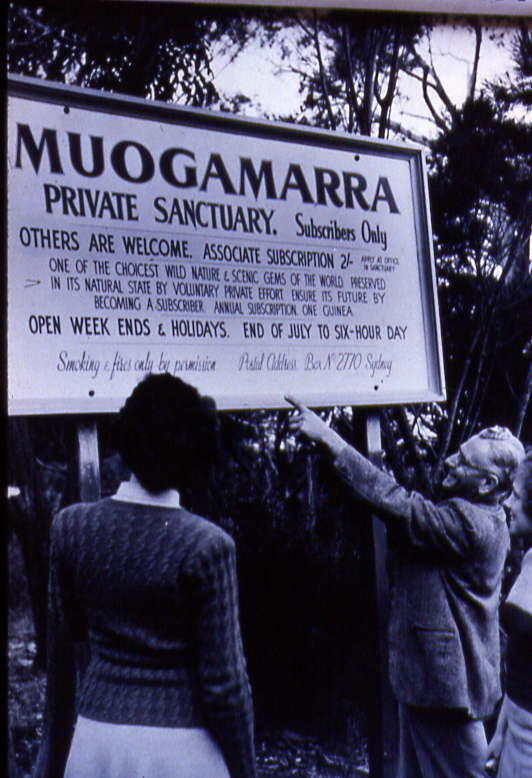
J.D. with Muogamarra sign. Photo courtesy Gibberagong Environmental Education Centre image collection. Original Source and Date Unknown. © State of New South Wales (Department of Education and Department of Environment and Heritage)
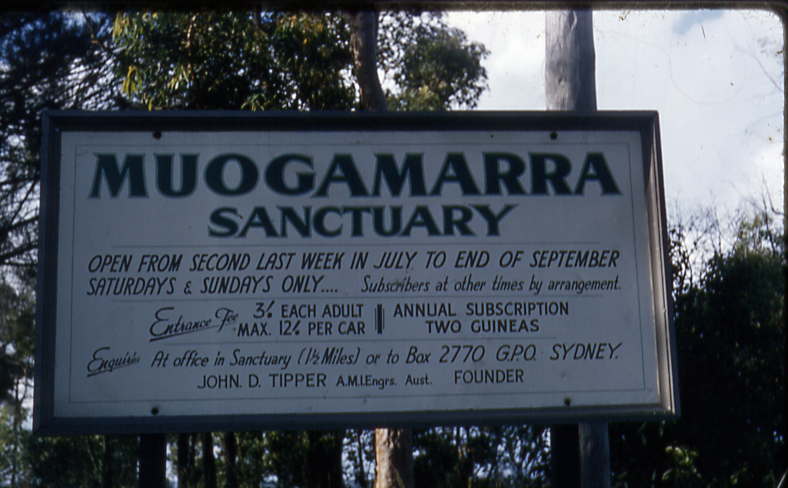
Native mammals and birds have responded to the safety afforded them. I saw many foot-prints and scratchings of lyrebirds. In forest hideouts, remote from visitors, are a number of koalas, and the possums there include the shy "gliders."
Mr. Tipper pointed to several shrubs that had to be protected by wire guards against the nibblings of wallabies.
Muogamarra has some interesting aboriginal rock carvings, but Mr. Tipper will not reveal their whereabouts. He says that is the only way to keep them undamaged.
"We insist that this is not a picnic ground, and camping is forbidden," Mr. Tipper said. "We don't want noisy parties. The sanctuary is only for those who would study and enjoy, in quiet surroundings, a piece of our bushland as near to its virgin state as we can keep it. We want to preserve it with the least amount of human intrusion."
Mr. Tipper, who was born at Maitland, is an engineer by profession. He recently retired from the Railways Department.
About 30 years ago he began to take special interest in the conservation of the area of Crown land that was to become Muogamarra. In 1933 be acquired part of it on Crown lease, and later added to it.
Volunteer Effort
He and several kindred enthusiasts formed the Australian Bushland Conservation Association to manage the place.
"The public will never know," said Mr Tipper, "what it cost us in money and labour - and blood, sweat, and tears - to establish and safeguard Muogamarra.
"The name Muogamarra - pronounced 'Moo-o-ga-marra' and meaning 'preserve for the future - was selected by me from the historic records of the Rev L. E. Threlkeld's research into the language of the Awabakal abor-gines of the Lake Macquarie district "
Now, as a result of the Government's action, Muogamarra will in future be controlled by a trust, of which Mr Tipper has been appointed chairman.
Also represented on the trust will be the Australian Bushland Conservation Association, the Royal Society, the Linnean Society, the botany department of Sydney University, the Naturalists' Society, the National Trust, and the Departments of Lands and Local Government. Fight To Preserve Bush Sanctuary (1953, July 18). The Sydney Morning Herald (NSW : 1842 - 1954), p. 2. Retrieved from http://nla.gov.au/nla.news-article18389135

J.D. Tipper, firefighter. Photo courtesy Gibberagong Environmental Education Centre image collection. Original Source and Date Unknown. © State of New South Wales (Department of Education and Department of Environment and Heritage)
Supported by the State government, Muogamarra Sanctuary was administered by trustees from 1954, with Tipper their president and resident curator.
Regulations for the Sanctuary were duly published and established:
Sydney, 25th January, 1957.
REGULATIONS FOR THE MANAGEMENT OF MUOGAMARRA SANCTUARY.
HIS Excellency the Governor, with the advice of the Executive Council, having approved of the following Regulations made by the Trustees for the management of the Muogamarra Sanctuary, dedicated 29th October, 1954, such regulations are hereby published for public information. P. 54-1,321.
ROGER NOTT, Minister for Lands.
The trustees of the area of about 2,050 acres, dedicated for the promotion of the study and conservation of native flora and fauna by notification in Gazette No. 178 of 29th October, 1954, and known as "The Muogamarra Sanctuary," hereby make the foliowing Regulations to apply to and in respect of the said area.
Proceedings of Trustees.
1. Regular meetings of the trustees shall be held at intervals of three months, and special meetings when authorised by the President or any two trustees.
2. Written notice of the date on which each meeting is to be held shall be given by the Secretary to each trustee at his last known place of abode or business, seven days before the proposed date of such meeting.
3. The annual meeting of the trustees shall be held in the month of July in each year at which meeting the trustees shall elect a President, Secretary, Treasurer, Auditor and such other officers and committees as may be considered necessary. Officers so elected may hold office until their successors are elected or until they are re-elected at the next annual meeting. The auditor shall be a qualified public accountant who is not a trustee and is not interested in any transaction of the trustees. Any vacancy occurring in any office shall be filled at the next regular meeting after the occurrence of such vacancy. The trustees shall notify the Minister in the event of a vacancy occurring amongst the trustees and of any change in the office of Secretary.
4. A resolution passed at any meeting shall not be rescinded unless upon at least seven days notice given and entered upon a notice of meeting sent to each trustee.
5. The Secretary shall keep a proper record of the proceedings of each meeting.
6. All moneys received shall be applied for the purposes of the Trust and shall be kept in such banks and with such accounts as the trustees may from time to time determine and such accounts shall be operated upon by cheques signed by either (a) two trustees and countersigned by the Secretary or Treasurer; or (b) by one trustee and a duly appointed officer and countersigned by the Secretary or Treasurer. It shall be sufficient for any one trustee or a duly appointed officer or the Secretary or Treasurer to endorse cheques for payment to the credit of any account of the trustees.
7. The trustees shall cause true accounts to be kept of all moneys received and expended, and of the matters in respect of which receipts and expenditures take place, and of the assets, credits and liabilities of the trustees. The books of account shall be kept at the" office of the trustees or at such place or places as the trustees think fit.
8. The financial year of the trustees shall commence on the first day of July in any year and shall close on the thirtieth flay of June in the following year.
9. A statement of the income and expenditure and a balance sheet containing a summary of the property and liabilities of the trustees made up to the thirtieth day of June in each year, and signed by the President and/or a duly appointed officer and countersigned by the Secretary and the Treasurer shall be laid before the trustees at the annual meeting. Every such statement shall be accompanied by a report as to the state and condition of the Sanctuary. Such report shall be signed by the President and/or a duly appointed officer and countersigned by the Secretary. A copy of such statement and report as adopted at such meeting shall be furnished to the Minister as soon as practicable after the meeting and upon the conclusion of the audit of the accounts.
10. In addition to the annual statement and report beforementioned a quarterly statement of income and expenditure and a bank certificate as to the bank balance, together with a report as to the activities carried out on the Sanctuary and as to the state of the Sanctuary, signed by the President and/or a duly appointed officer and countersigned by the Secretary, shall be placed before the trustees.
General.
11. No person shall without the permission of the trustees enter or be within the Sanctuary except at such times as the trustees may determine and indicate by such means as the trustees may from time to time determine.
12. No person shall enter the Sanctuary except by way of the entrance gates, nor shall any person enter or be upon any part of the Sanctuary which the trustees set apart and indicate by such means as the trustees may from time to time determine.
13. The fees payable by persons entering the Sanctuary or for the use of any of the facilities of the Sanctuary shall be such as the trustees shall determine and indicate by such means as the trustees may from time to time determine.
14. The trustees may either generally or in any particular case prescribe what persons may or may not be permitted to visit the Sanctuary, and also the fees payable by visitors upon entry or for the use of any of the facilities of the Sanctuary or otherwise, and also any terms and/or conditions which they may consider reasonable to impose upon any visitors whether generally or specially.
15. No persons under the age of 16 years shall enter or be within the Sanctuary unless accompanied by an adult who will be held responsible for their conduct while within the Sanctuary.
16. No person shall enter upon or remain upon the Sanctuary unless suitably clad to the satisfaction of the trustees or their duly authorised agent or servant.
17. No person shall, within the Sanctuary, collect specimens of plants or parts thereof or of any bird, animal, reptile, insect or other thing organic or inorganic, but the trustees or a duly authorised officer may grant permission to scientific workers to collect specimens or to refer to any collection or library of the trustees. Such permission may be refused, or if granted may be upon such terms and conditions as the trustees or authorised officer think fit and may at any time be withdrawn.
18. No person shall remove, destroy or damage any tree, shrub, fern, creeper, vine, palm, plant, flower, herbage or vegetative cover or remove, destroy, injure or disturb any animal, bird, fish or any other fauna or bird's nest or animal resting place within the Sanctuary, but shall respect the Sanctuary as a Primitive Area to be retained as an historic relic of the original Hawkesbury Sandstone Flora Region.
19. No person shall bring into or leave within the Sanctuary any plant whatsoever whether indigenous or not without the express prior permission of the trustees or authorised officer.
20. No person shall bring into or leave, within the Sanctuary any dog, cat or other animal or take away or remove anything whatsoever from its location within the Sanctuary.
21. No person shall depasture any stock within the Sanctuary.
22. No person shall bathe in or pollute in any way whatever the water of any tank, spring, waterhole or pool with hi the Sanctuary, or cleanse any dish, cooking or eating utensil, cloth, object or thing in such water, or place any food scraps or any objectionable matter or thing in such water or on the bank, verge or edge thereof.
23. No person shall fasten or attach any boat or vessel to any part of the Sanctuary.
24. No person shall deposit, discharge or leave or cause to be deposited, discharged or left any litter, rubbish, dirt, offal, dung, dead animal or objectionable matter within or upon the Sanctuary.
25. No person shall deposit, discharge or leave or cause lo be deposited, discharged or left any refuse within or upon the Sanctuary except in the receptacles provided.
26. No person shall deposit "within the Sanctuary any glass or any container or object of similar material which would occasion risk of fire or injury to persons or property.
27. No unauthorised person shall light a fire or fires or shall smoke or use matches or unprotected lights or fires outside the areas or places specially set apart for these purposes by the trustees and indicated by such means as the trustees may from time to time determine and no person shall leave a fire unattended or fail to take precautions to prevent a lire spreading or fail either to properly extinguish a fire with water or cover it with an adequate depth of sand or earth.
28. No person shall make drawings, paintings, photographs or the like or in any way depict any tree, plant or flower, bird or animal or other feature of the Sanctuary or of any view to be seen from the Sanctuary without the permission of the trustees or their authorised officer. The trustees may levy a charge for reproductions of such whether on a royalty basis or otherwise and may require that due acknowledgment in terms as directed by the trustees or their authorised officer be made on such reproductions or in such other manner as they may direct.
29. No person shall erect any hoarding or display or distribute any advertising material of any kind, or sell or attempt to sell any goods, articles or commodities within the Sanctuary.
30. No person shall park or leave any vehicle within the Sanctuary except in an area set aside by the trustees for the purpose and indicated by such means as the trustees may from time to time determine.
31. No person shall, unless authorised by the trustees, bring into or use within the Sanctuary any axe, saw or similar tool or implement, or any firearm or other lethal weapon or any trap of any kind whatsoever.
32. No person shall throw any stones or missiles or without the permission of the trustees perform any vocal or instrumental music or use a radio receiving set within the Sanctuary.
33. No person shall, without the permission of the trustees, address any public meeting or assemblage of persons within the Sanctuary.
34. No person shall interfere with any instrument or equipment used within the Sanctuary, or write, carve, draw or scratch upon or otherwise deface any tree, sign or other property vested in the trustees.
35. No person shall walk over, mark, scratch or otherwise mutilate, deface, injure, interfere with or destroy any aboriginal petroglyph, its surrounds or any other aboriginal relic within the Sanctuary. The trustees may grant permission to scientific workers, accredited students and others having a special interest in ethnological study of aboriginal petroglyphs or other relies of the aborigines to inspect such petroglyphs and their surrounds and other relics. The trustees in granting such permission may do so upon such conditions as they think fit and they may withdraw such permission.
36. No person shall climb any tree or building or commit any nuisance within the Sanctuary.
37. No person shall use any part of the Sanctuary for playing games or sport, or for camping, hiking or any industrial or commercial activity whatsoever, or without the permission of the trustees for picnicking thereon.
38. Any person trespassing or causing annoyance or inconvenience on any part of the Sanctuary may be removed by any trustee or any duly authorised agent or servant of the trustees.
39. No person shall obstruct the trustees or their duly authorised agents or servants in the discharge of their duty.
40. Any person committing a breach of these regulations shall be liable to a penalty not exceeding Fifty Pounds.
Dated this thirty-first day of July, 1956.
JOHN DUNCAN TIPPER,
Founder of the "Muogamarra" Sanctuary and President of the Trust.
ROBERT HENRY ANDERSON, STANLEY HAYILAND, SPENCER LOWE, JOHN McLUCKIE, HAROLD HAMILTON MOORE, FRANCIS CLINTON RAYMOND PELHAM, ALLAN FREDERICK SALMON, JOYCE WINIFRED VICKERY. Trustees.
REGULATIONS FOR THE MANAGEMENT OF MUOGAMARRA SANCTUARY. (1957, January 25). Government Gazette of the State of New South Wales (Sydney, NSW : 1901 - 2001), p. 223. Retrieved from http://nla.gov.au/nla.news-article220350003
In 1967 the newly established National Parks and Wildlife Service assumed control of Muogamarra. Mr. Tipper grew increasingly angered by its management practices. Disagreements over the level of protection afforded to Aboriginal relics within Muogamarra combined with his own ill health to end his association with the sanctuary in 1968.
Schooled at West Maitland, J. D. Tipper joined the electrical tramways branch of the New South Wales Government Railways and Tramways on 13 December 1910 and worked as a tracer.
He studied fitting and turning (1912-13) and electrical engineering (1914-17) part time at Sydney Technical College and qualified as an associate (1920). Promoted to draftsman in 1917, Tipper was an assistant-engineer from 1929 until he retired as engineer (third class) in October 1952. He was an associate-member of the Institution of Engineers, Australia.
At St James's Church of England, Sydney, on 5 December 1912 he married Florence Wynn Clarke. The couple had at least one child, Laurence John Tipper, born 1914 with the birth registered at Petersham.
MARRIAGES.
TIPPER— CLARKE.— December 5, 1912, at St. James's, King-street, by the Rev. F. W. Greville, John Duncan, son of late E. Tipper and Mrs. E. Tipper, of West Maitland, N.S.W., to Florence Wynn, elder daughter of late Geo. Lewis Clarke, of Rosewood station, Q., and Mrs. J. B. Clarke, of Darlinghurst. Family Notices (1913, January 21). The Sydney Stock and Station Journal (NSW : 1896 - 1924), p. 2. Retrieved from http://nla.gov.au/nla.news-article124122228
TIPPER.-October 27, 1914, at a private hospital, Stanmore, to Mr. and Mrs. J. D. Tipper-a son (Laurence James). Family Notices (1914, November 14). The Sydney Morning Herald (NSW : 1842 - 1954), p. 12. Retrieved from http://nla.gov.au/nla.news-article15549764
Florence was an Honorary Ranger as well:
BIRDS AND ANIMALS PROTECTION ACT, 1918-1930.
Appointment of Honorary Rangers.
THE undermentioned persons have been appointed as Honorary Hangers in pursuance of the provisions of the Birds and Animals Protection Act, 1918-1930, viz.:— Florence Wynn Tipper, 72 Midson-road, Epping. Hubert James Bear, Venetia-avenue, Blackalls, via Toronto.
G. C. GOLLAN. BIRDS AND ANIMALS PROTECTION ACT, 1918-1930. (1937, November 12). Government Gazette of the State of New South Wales (Sydney, NSW : 1901 - 2001), p. 4509. Retrieved from http://nla.gov.au/nla.news-article225129029
WILD FLOWEBS IA.ND NATIVE, PLANTS PROTECTION ACT, 1927.
Appointment of Honorary Rangers.
THE undermentioned persons have been appointed as Honorary Bangers in pursuance of the provision of the' Wild Flowers and Native Plants Protection Act, 1927:— Florence Wynn Tipper, 72 Midson-road, Epping, N.S.W. Hubert James Bear, "Venetia-avenue, Blackalls, via Toronto, N.S.W. (L.G. 1937-G. 3,685)
J. B. SHAND (for Minister for Works and Local Government). Department of Works and Local Government, Sydney, 17th December, 1937. WILD FLOWERS AND NATIVE PLANTS PROTECTION ACT, 1927. (1937, December 17). Government Gazette of the State of New South Wales (Sydney, NSW : 1901 - 2001), p. 4982. Retrieved from http://nla.gov.au/nla.news-article225130385
Their son also followed through:
Sydney, 9th November, 1956.
IT is hereby notified that, in accordance with the provisions of section 26 of the Crown Lands Consolidation Act, 1913, Laurence James Tipper is hereby appointed as a trustee of an area of about 2,050 acres, parish of Cowan, county of Cumberland, dedicated 29th October, 1954, for the Promotion of the Study and Conservation of Native Flora and Fauna, find known as Muogamarra Sanctuary, in the place of H. H. Moore, resigned. P. 56-5,473.
ROGER NOTT, Minister for Lands. Government Gazette Appointments and Employment (1956, November 9). Government Gazette of the State of New South Wales (Sydney, NSW : 1901 - 2001), p. 3311. Retrieved from http://nla.gov.au/nla.news-article220347292
Florence passed away at Rooty Hill on July 10, 1966, apparently 92 years of age according to NSW Births, Deaths and Marriage Records, which means she would have been 8 years older than her husband.
Now an elderly widower, J.D. married Ballina born lady Enid Constance Monaghan (1909-1995) at St Margaret's Presbyterian Church, Turramurra, on 22 August 1966.
Mr. J D Tipper passed away on 8 September 1970 at Wahroonga and was cremated with Anglican rites; his wife survived him, as did the son of his first marriage.
Laurence married Sylvia Patricia Luke (1922–1971) in 1940, with the marriage registered at Waverly. He passed away on August 29 2001.
'J.D.' (as Tipper was known to his friends) was a passionate naturalist who believed that conservation was a calling 'as exacting, responsible and individualistic as any of the senior professions'. [1.]
Continued as it began, each year 'Muogamarra Sanctuary' opens to the public for six weeks to enable people to see and learn about its native beauty and Aboriginal heritage.
This year's Muogamarra Open Season, from 17 August to 22 September, quickly sold out, with all 4,786 tickets snapped up. Father's Day on 1 September, the first day of Spring 2024, was as popular as ever, with many families enjoying guided tours and self-guided walks.
Muogamarra protects more than 900 native plants, including wildflowers such as waratahs, majestic angophoras, old-man banksias, pink boronias and delicate native orchids, which are in bloom when the reserve is open to the public in August and September.
The nature reserve is also home to 14 species of native mammals, including the swamp wallaby, brush tail possum and echidnas, while birdwatchers may glimpse a soaring wedge-tail eagle or the endangered glossy black-cockatoo.
The landscape and sites remain significant to local Aboriginal people as connection to Country and for passing on knowledge to future generations. The reserve contains evidence of Aboriginal heritage including engravings, grinding grooves and shell middens.
Walking tracks around the nature reserve offer views of the Hawkesbury River and Berowra Creek, as well as expansive vistas of Bar, Milson, Long and Spectacle islands.
Since its inception in 1934, public access has been restricted to preserve the area's high conservation values. NSW National Parks and Wildlife Service continues to open the reserve for a short period during wildflower season in honour of J D Tipper's early vision.
Minister for the Environment Penny Sharpe, who served as Shadow Minister for Environment prior to undertaking her current work, visited Muogamarra Nature Reserve on Sunday 1 September 2024, said:
"Every year Muogamarra Nature Reserve is open to the public for just six weeks to allow nature lovers to visit this unique area.
"I want more people to know about this treasure, so they can get their hands on a ticket next year.
"It's home to more than a dozen native animals and more than 900 plants, including magnificent wildflowers.
"For 90 years, volunteers have been looking after this precious reserve just north of Sydney. I would like to thank each and every one of them for their hard work and dedication to protect this treasure."
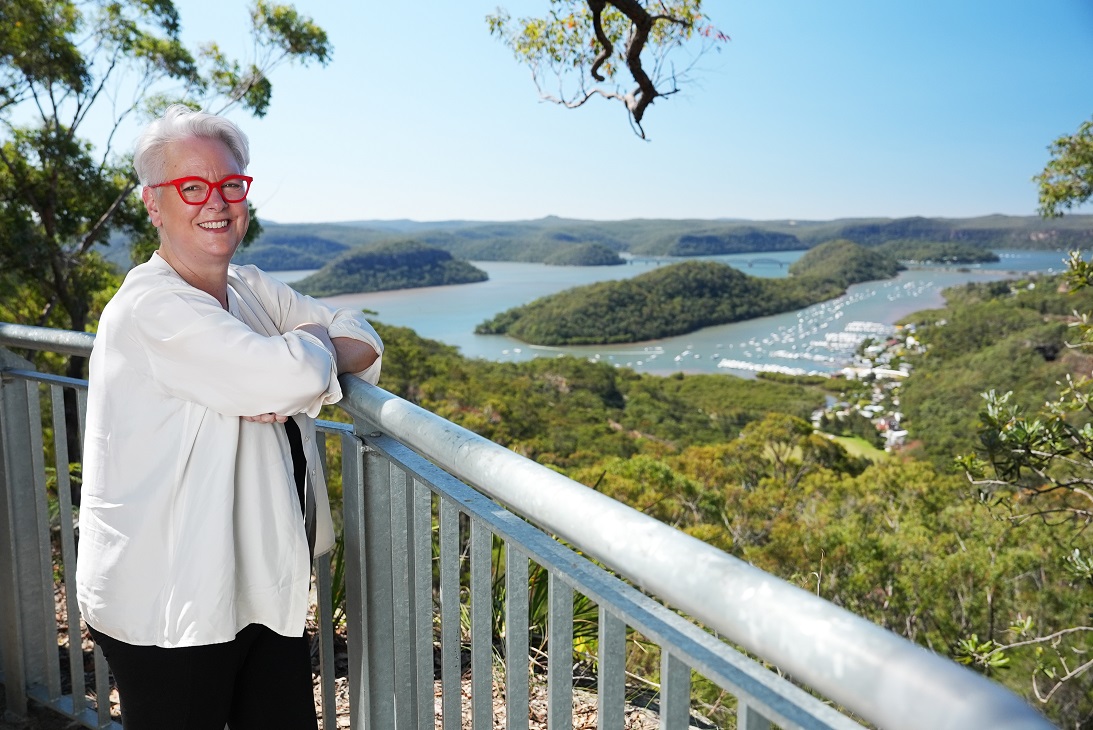
Minister for the Environment, The Hon Penny Sharpe visited Muogamarra Nature Reserve on Sunday 1 September 2024. This shows the 2024 view from Tippers' Lookout behind her.
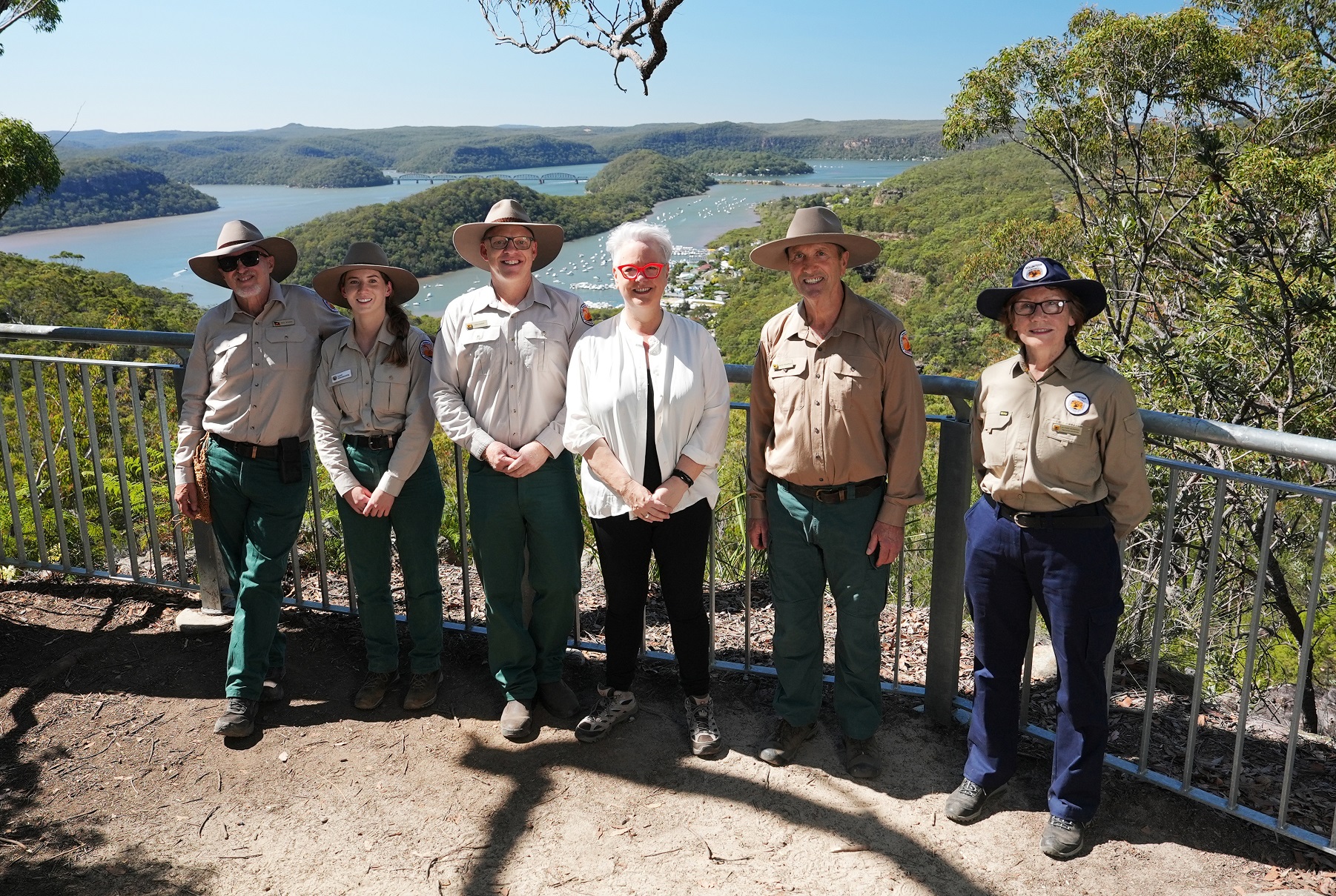
Left to right:
Eric Keidge – North Western Sydney Field Officer, NSW National Parks and Wildlife Service
Sarah Glendenning – Local Ranger, NSW National Parks and Wildlife Service
Greg Kirby – North Western Sydney Area Manager, NSW National Parks and Wildlife Service
The Hon Penny Sharpe – Minister for the Environment
David Thompson – Discovery Coordinator, Muogamarra Nature Reserve
Susan Rumble – Chase Alive Discovery programme volunteer tour guide, Muogamarra Nature Reserve
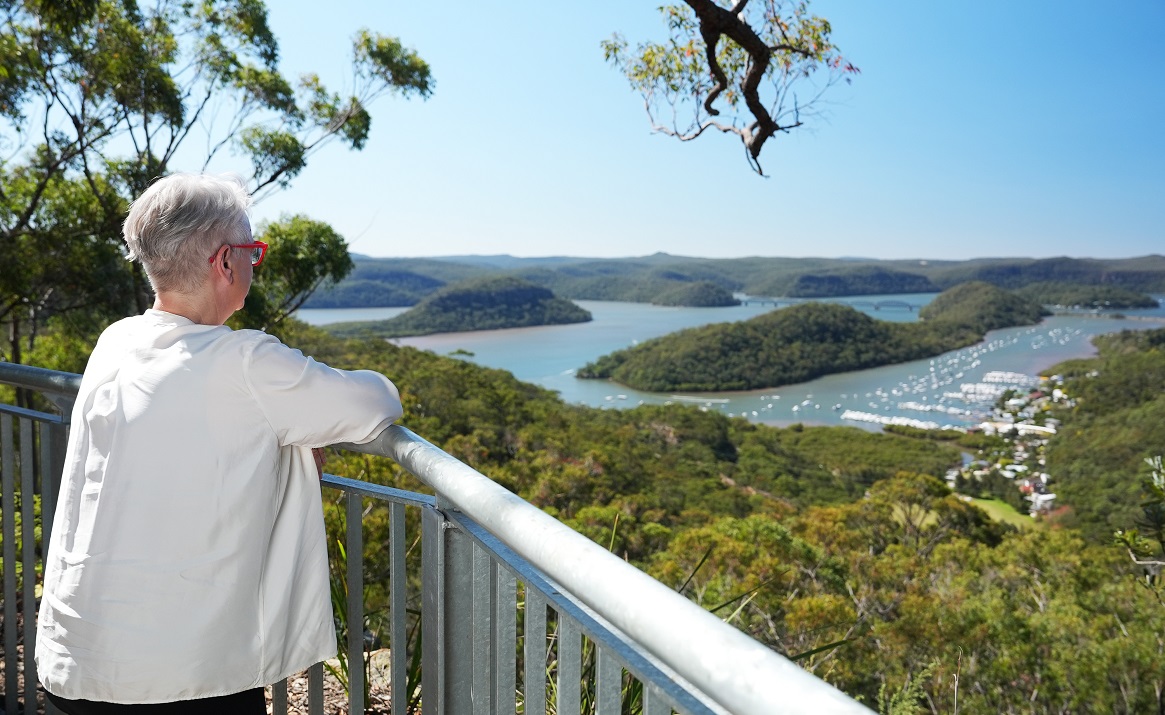
Minister for the Environment, The Hon Penny Sharpe, gets one quiet moment in the Muogamarra Nature Reserve on Sunday 1 September 2024.
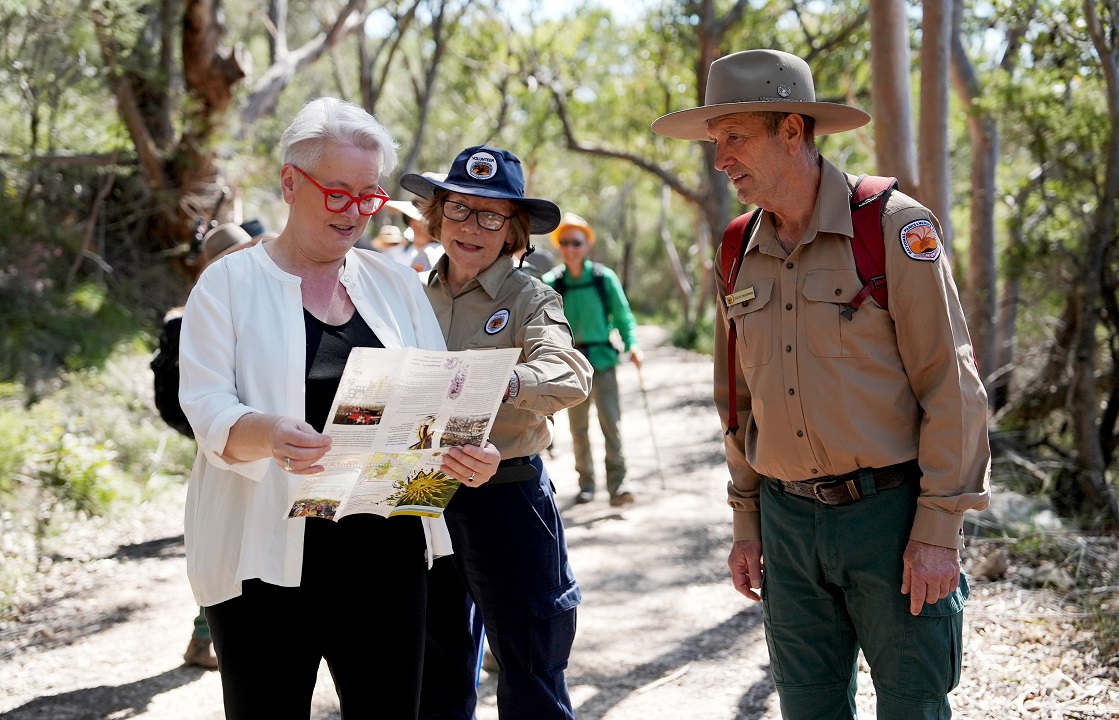
The Hon Penny Sharpe – Minister for the Environment, with Susan Rumble – Chase Alive Discovery programme volunteer tour guide, Muogamarra Nature Reserve and David Thompson – Discovery Coordinator, Muogamarra Nature Reserve

Muogamarra Track Map, courtesy NSW NPWS
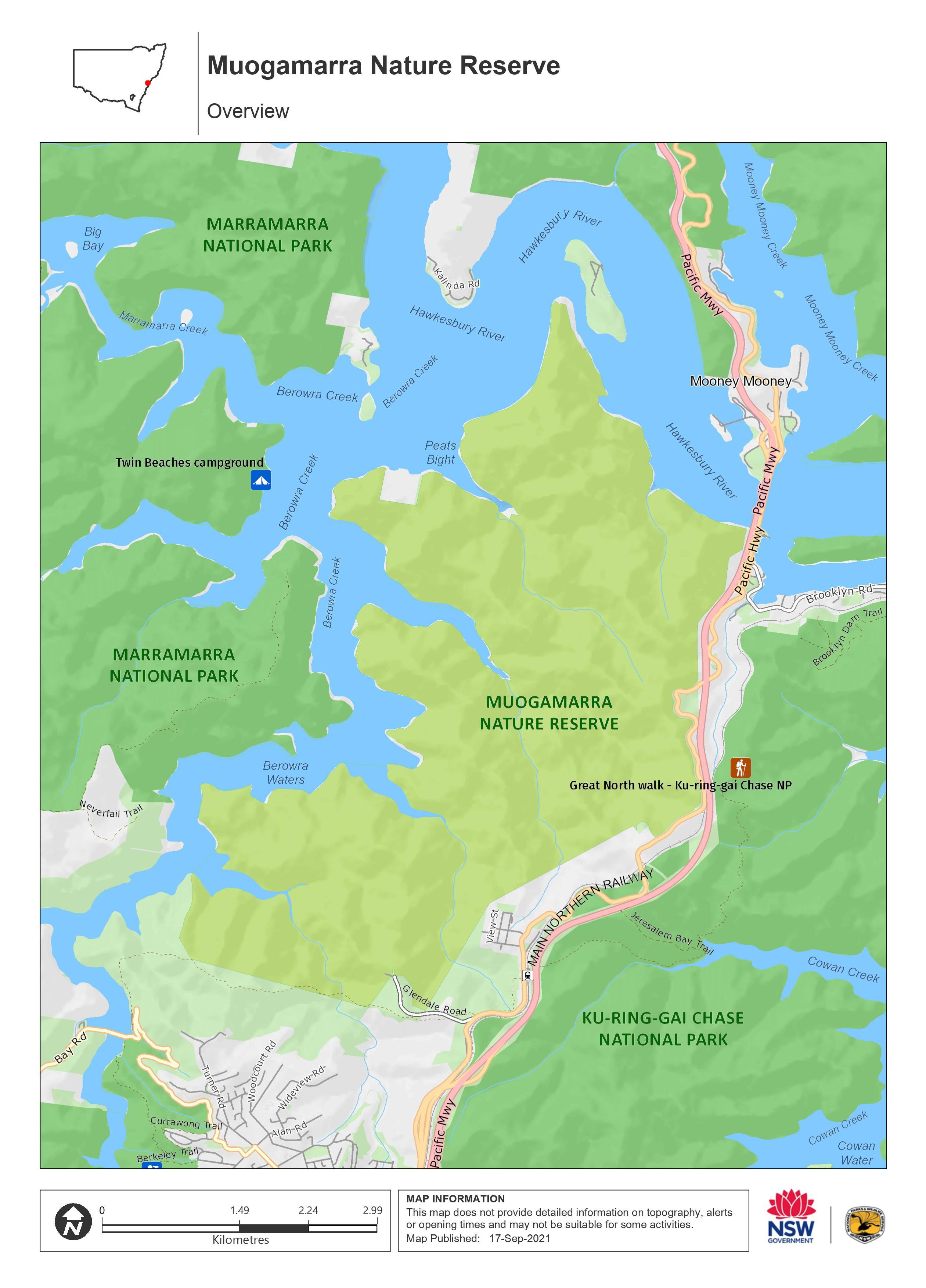
Muogamarra Nature Reserve Map, courtesy NSW NPWS
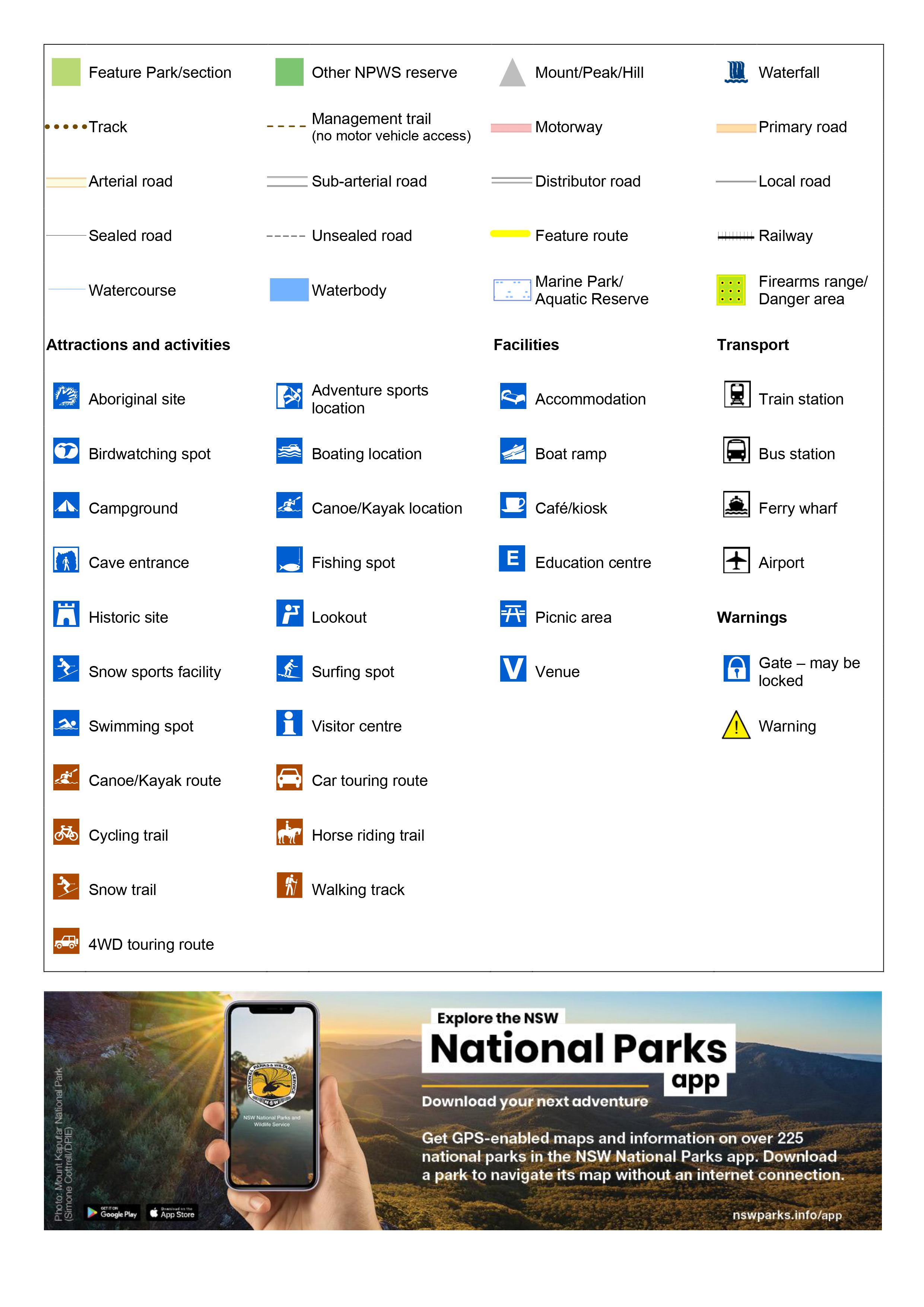
Muogamarra Field Studies Centre
Muogamarra FSC was founded in 1971 and opened in 1972 as part of an agreement between the NSW Department of Education (DoE) and the NSW National Parks and Wildlife Service (NPWS).
Although now located at Bobbin Head and called Gibberagong Environmental Education Centre (EEC), the school continues to teach thousands of local school students at the site each year (particularly in the cooler months) and are custodians in ensuring it continues as a place of education into the future. Many of the buildings at the site, including the classroom, toilet block and COLA, were built and are currently maintained by the DoE.
Muogamarra FSC continues to offer a range of programs, including:
- Primary Excursions
- Secondary Excursions
- Overnight Programs
- Incursion programs
- Resources Hub
- Special Programs
- Professional Learning
For more information about our school, please visit the Gibberagong EEC website: gibberagon-e.schools.nsw.gov.au
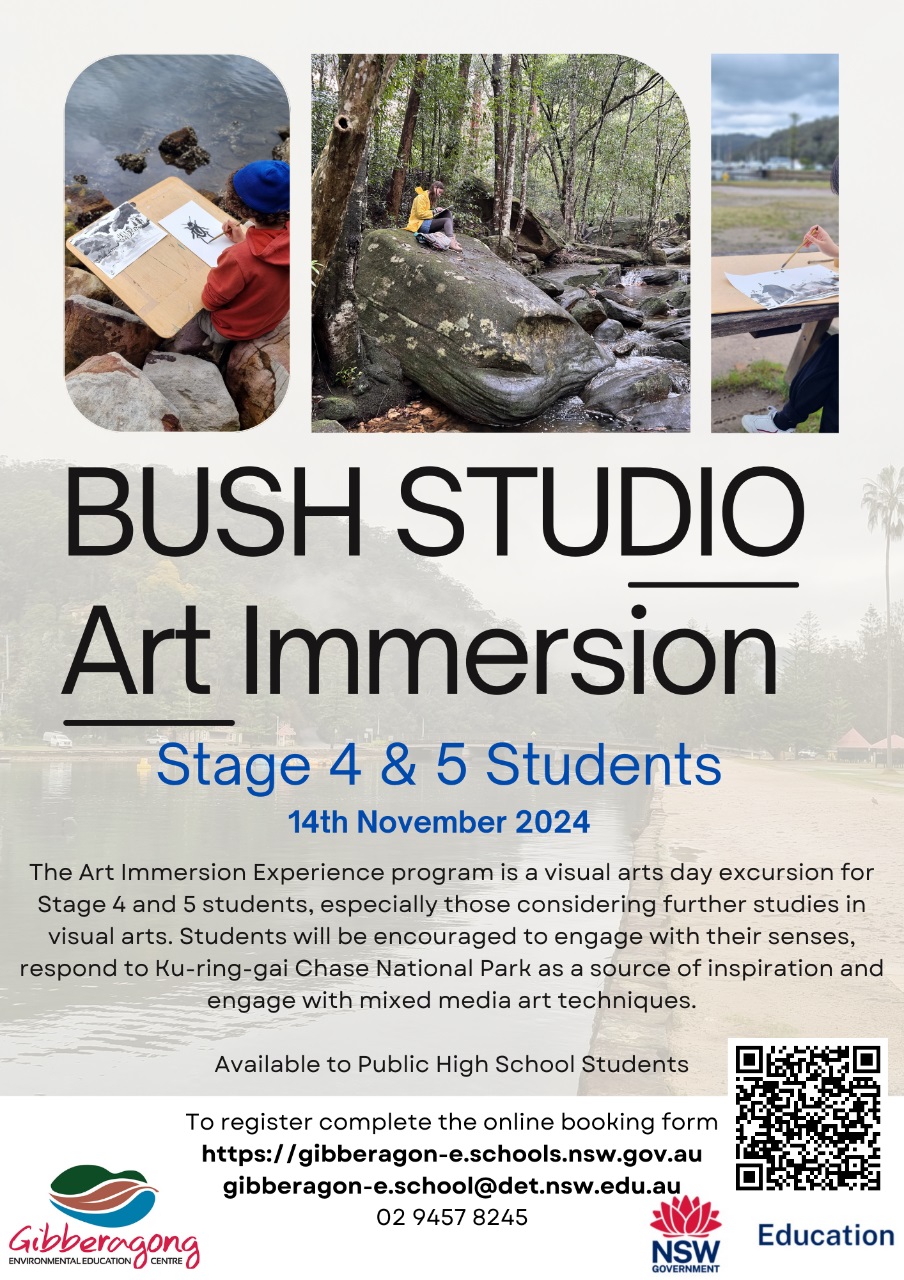
References - Extras
- Richard Gowers, 'Tipper, John Duncan (1886–1970)', Australian Dictionary of Biography, National Centre of Biography, Australian National University, https://adb.anu.edu.au/biography/tipper-john-duncan-11867/text21247, published first in hardcopy 2002
- David Clune, 'Sheahan, William Francis (1895–1975)', Australian Dictionary of Biography, National Centre of Biography, Australian National University, https://adb.anu.edu.au/biography/sheahan-william-francis-11669/text20851, published first in hardcopy 2002
- A J Guesdon. A Bunch Of Wildflowers: Historical Spring September Songs, Pittwater Online News, https://www.pittwateronlinenews.com/A-Bunch-Of-Wildflowers-History-Spring-Songs.php, published first 2018 and refreshed 2020
- A J Guesdon Harry Wolstenholme - June 21, 1868 - October 14, 1930: Ornithologist Of Palm Beach, Bird Man Of Wahroonga, Pittwater Online News, https://www.pittwateronlinenews.com/Harry-Wolstenholme-Ornithologist-Of-Palm-Beach.php, October 2020
- A J Guesdon. Annie Wyatt Reserve: Palm Beach- Pittwater Fields of Dreams II, Pittwater Online News, https://www.pittwateronlinenews.com/Annie-Wyatt-Reserve-Palm-Beach-History.php, November 2016
- A J Guesdon. Pittwater's Lone Rangers - 120 Years of Ku-Ring-Gai Chase and the Men of Flowers Inspired by Eccleston Du Faur, Pittwater Online News, https://www.pittwateronlinenews.com/pittwaterslonerangers120yearsofkuringgaichase.php June 2014
- G Searl and A Guesdon. Grand Old Tree Of Angophora Reserve Falls Back To The Earth, Pittwater Online News, https://www.pittwateronlinenews.com/Grand-Old-Tree-Of-Angophora-Reserve-Falls-2022.php, August 2022
- A J Guesdon. Stokes Point Careel Bay: the shift from Warner's Hut in 1813 to Finisterre in 1924; 1934 additions probably designed by Australia's First Female Architect, Beatrice (Bea) May Hutton - A Pittwater Rendezvous Site for Royal Sydney Yacht Squadron Members is Still A Home With A View For Those With A Passion For Sailing, Pittwater Online News, https://www.pittwateronlinenews.com/Stokes-Point-Homes-Warners-Hut-to-Finsterre.php, August 2023
- A J Guesdon. Ten years on ‘Hands Off Barrenjoey!’ remains the song, Pittwater Online News, https://www.pittwateronlinenews.com/Ten-years-on-Hands-Off-Barrenjoey-remains-the-song.php, January 2023
- A J Guesdon. Short-term accommodation in Barrenjoey Headland Buildings Ruled out: Formalisation of Plan of management to occur soon, Pittwater Online News, https://www.pittwateronlinenews.com/Barrenjoey-Cottages-Accommodation-Quashed-2024.php, January 2024
- A J Guesdon. Adoption Of The Ku-Ring-Gai Chase National Park, Lion Island Nature Reserve, Long Island Nature Reserve And Spectacle Island Nature Reserve Plan Of Management: February 2024 + West Head Lookout Works Now Completed, Pittwater Online News, https://www.pittwateronlinenews.com/Barrenjoey-Cottages-Accommodation-Quashed-2024.php, February 2024
- A J Guesdon. Manly Wildflower Shows: Some History, Pittwater Online News, published September 2024
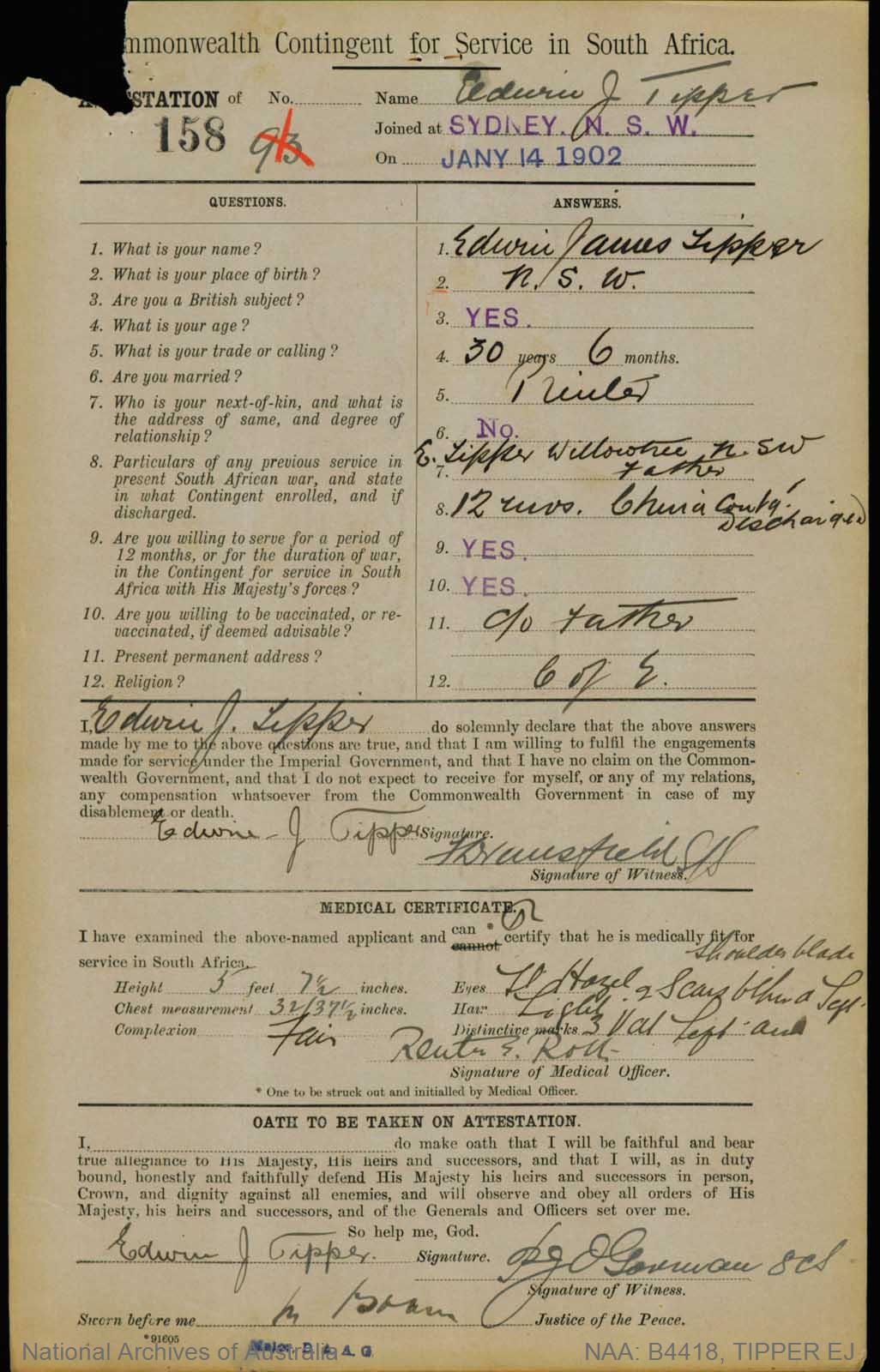

Q.C.'s WIFE DROVE A STOLEN CAR
Lady Maughan, wife of Sir David Maughan, Q.C., yesterday drove a "stolen" car for several hours. Mr. Laurence Tipper, of Epping, telephoned police just before lunch that his car had been stolen from Pacific Highway, Lindfield. Police broadcast a description of the car, and searched for it for hours.
Meanwhile Lady Maughan had driven the car from Pacific Highway, Lindfield, to the city, .and later to her home at Lindfield. About 7 pm. she parked It in her garage, but later found that it was not hers. The two cars, which were identical, had been parked about 30 feet apart in Pacific Highway, Lindfield. The key had been left In the dashboard of Mr. Tipper's car, in which Lady Maughan drove away. Q.C.'s WIFE DROVE A "STOLEN" CAR (1953, March 31). The Daily Telegraph (Sydney, NSW : 1931 - 1954), p. 2. Retrieved from http://nla.gov.au/nla.news-article248863932
CARELESS USE OF FIRE ACT, 1912, AS AMENDED BY THE BUSH FIRES ACT, 1930.
Appointment of Honorary Rangers.
THE undermentioned persons have been appointed as Honorary Rangers in pursuance of the provisions of section 8a of the Careless Use of Fire Act, 1912, as inserted by the Bush Fires Act, 1930:—
Davies, Francis Lewis, Finisterre, Stokes Point, Careel Bay, Pittwater. CARELESS USE OF FIRE ACT, 1912, AS AMENDED BY THE BUSH FIRES ACT, 1930. (1930, December 19). Government Gazette of the State of New South Wales (Sydney, NSW : 1901 - 2001), p. 4955. Retrieved from http://nla.gov.au/nla.news-article220234670
BIRDS AND ANIMALS PROTECTION ACT, 1918- 1930.
Appointment of Honorary Rangers.
THE undermentioned persons have been appointed as Honorary Bangers, in pursuance of the provisions of the Birds and Animals Protection Act, 1918-1930:—
Francis Lewis Davies, Finisterre, Stokes Point, Careel Bay. BIRDS AND ANIMALS PROTECTION ACT, 19181930. (1930, November 14). Government Gazette of the State of New South Wales (Sydney, NSW : 1901 - 2001), p. 4580. Retrieved from http://nla.gov.au/nla.news-article220233247
RANGERS' LEAGUE. Mr. Francis Lewis Davies has been appointed honorary secretary to the Rangers' League. Mr Percy A. Meggy, who until recently held the office of honorary secretary, is now the honorary editor for the league. RANGERS' LEAGUE. (1931, June 19). The Sydney Morning Herald (NSW : 1842 - 1954), p. 10. Retrieved from http://nla.gov.au/nla.news-article16787048
RANGERS' LEAGUE.
Group Committees Suggested.
The report of the council of the Rangers' League, presented at the annual meeting of the league last night, stated that as an indication of the public confidence in the league, the owners of the residue of Pymble forest had voluntarily given it the care of the forest. Steps were being taken to ensure its protection, in conjunction with the Forestry Commission.
The meeting recommended that the council should be increased to give wider scope to its activities, the latter to be divided into groups controlled by sub-committees, and that meetings should be held in various centres to form group committees or branches. RANGERS' LEAGUE. (1933, October 27). The Sydney Morning Herald (NSW : 1842 - 1954), p. 12. Retrieved from http://nla.gov.au/nla.news-article17019335
More on the Pymble Forest in: Annie Wyatt Reserve: Palm Beach - Pittwater Fields of Dreams II
PICKING WILD FLOWERS. Warning by Minister.
The Minister for Works and Local Government, Mr. Spooner, has issued a warning to the public not to disregard the provisions of the Wild Flowers and Native Plants Protection Act during the approaching wild flower season. Picking protected wild flowers, which Includes any interference with the plants, prohibited on all Crown land, State forests, public parks, and public reserves throughout New South Wales." Under the law, it is presumed that all persons, who are found with protected plants in their possession have obtained them illegally unless they can furnish proof to the contrary.
THOSE PROTECTED. Under the Act, protection is given to boronia, waratah, flannel flower, Christmas bush, criostemon. Christmas bells, bottlebrush, stag horn, elk horn, tree fern, maiden hairfern, and most native orchids, and many other wild plants which are in danger of early extinction owing to vandals who, In the past, have been at liberty to destroy all the attractive native flowers accessible to them. Offenders are liable to fines of up to £20.During the last two seasons, nearly 200 persons were convicted In the metropolitan district alone. Besides the police, about 700 honorary rangers, appointed by the Minister, are operating to patrol the bush and exercise the powers of members of the police force in apprehending and prosecuting suspected offenders. Weekend "drives" have been instituted by the Rangers' League, in conjunction with the police, against motorists leaving the vicinity of Ku-ring-gai Chase and National Park. Ku-ring-gai Chase National Park. PICKING WILD FLOWERS. (1938, September 3). The Sydney Morning Herald (NSW : 1842 - 1954), p. 5. Retrieved from http://nla.gov.au/nla.news-article17515440
And another:
WILD FLOWER GARDEN. An Urgent Need. (BY DAVID G STEAD PRESIDENT, AUSTRALIAN FOREST LEAGUE )
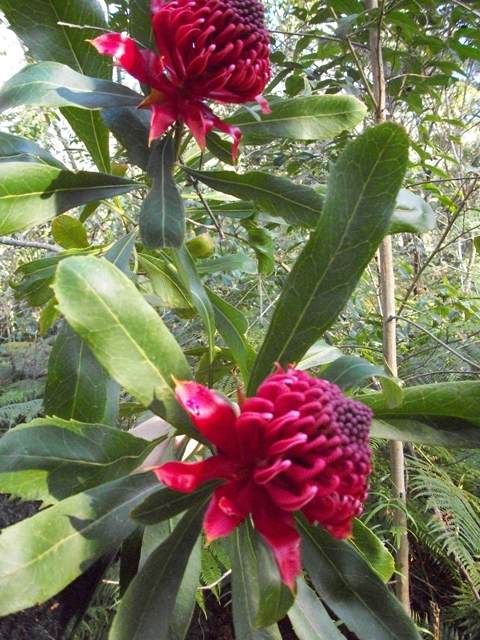 For many years past the Wild Life Preservation Society of Australia and the Australian Forest League have been urging the establishment of a nature park in the metropolitan area of Sydney, of an entirely different order to any of the existing reserves or parks This would be an area of land entirely devoted not only to the preservation, but to the de-liberate cultivation of a number of the glorious wild flowers for which the Sydney sand-stone district has become so justly famous, in Australia, and throughout the world Though the need for this has been quite apparent to many wild-bush lovers for a long time, it has recently become most urgent, owing to the rapid spread of settlement in nearly every portion of the sandstone country and the widespread bush depredations of trippers, wildflower dealers, and the devastation caused by bushfires
For many years past the Wild Life Preservation Society of Australia and the Australian Forest League have been urging the establishment of a nature park in the metropolitan area of Sydney, of an entirely different order to any of the existing reserves or parks This would be an area of land entirely devoted not only to the preservation, but to the de-liberate cultivation of a number of the glorious wild flowers for which the Sydney sand-stone district has become so justly famous, in Australia, and throughout the world Though the need for this has been quite apparent to many wild-bush lovers for a long time, it has recently become most urgent, owing to the rapid spread of settlement in nearly every portion of the sandstone country and the widespread bush depredations of trippers, wildflower dealers, and the devastation caused by bushfires
The sort of wild flower garden that Is visualised by me would not be at all a costly affair either to produce or to maintain In fact, once it was established, and reticulated with rough bush paths-merely for the purpose of keeping visitors to definite tracks and so that the wild flowers would lie undisturbed-one resident caretaker, possessed of the right knowledge, with the help of one junior assistant, could successfully maintain a considerable area carpeted with, say, native rose and other boronias, flannel flower, Christmas bells, etc, intermingled with protecting clumps of Christmas bush, waratahs, red bottle-brush, wattles, and Banksias The possibilities of such a wild garden can hardly be exaggerated It could not only be one of the great sights of Sydney, but would be the talk of every oversea traveller, from all parts of the world
The Sydney sandstone country, while sounding promising from the agriculturist's stand-point, is possessed of the greatest collection of natural wild bush flowers to be found in any area of similar size in the world-I mean to say, the greatest aggregation of prominent flowering species But, to gaze at many of the hillsides to-day one would hardly think this could have been so While it is quite hopeless for us to expect to restore this pristine beauty over any large area, there Is nothing whatever in a practical way to prevent our establishing the sort of nature park that I have suggested, where, in addition to the massing of a few notable kinds of great charm and beauty, we might readily have a representation, at least of a hundred others
Such an area as one has in mind can be found to-day in, say, the French's Forest area, Davidson Park a part of Kuring-gai Chase, and perhaps Lindfield Park. There are other places, also, which will suggest themselves to some of our nature lovers and bushwalkers I would strongly emphasise the point however, that it will not be sufficient for any public body or local authority to merely set aside an area for the purpose with a view to "leaving nature to herself," as it is often foolishly put. To leave nature to herself In any of our bush districts now, means constant depredation and bushfire The work must be organised from the beginning, and there must be a resident caretaker The total cost need not be more than about £600 per annum, as all the necessary advisory work, I can guarantee, will be supplied in an honorary capacity by expert men and women
This projected wild flower garden would be intensely popular-especially during the main flowering months of spring and early summer. Probably additional protective work would be necessary during that season but I am confident that we can arrange for such at the peak periods of public interest, without extra cost to the community I hope earnestly that our people will take up this Important matter-of such moment to ourselves and to posterity-without further delay While we dally the magic carpet of the bush is dissolving before our very eyes. WILD FLOWER GARDEN. (1932, April 6). The Sydney Morning Herald (NSW : 1842 - 1954), p. 15. Retrieved from http://nla.gov.au/nla.news-article16853648
The Ku-Ring-Gai Chase Wildflower Garden was established in 1967, the same year the National Parks and Wildlife Service was created. As described above, it has Walking Tracks, Picnic Areas and Wildflower Displays - area - 123 hectares - entrance at 420 Mona Vale Road, St Ives.
One last protest from another kind of trailblazer that may make us all begin planting more Native Species:
VANDALS WARNED
Action To Protect :. Wild Flowers.
Sir,-The trustees of the Ku-ring-gai Chase-are very much concerned at the destruction and despoliation of native flora. The destruction of wild flowers by unthinking pickers and commercial-minded thieves is appalling, despite all our efforts. The flannel flower, once, so common, is now almost a thing of the past. In areas where a very few years ago millions of Christmas Bells made the bush a thing a beauty, scarcely one is now to be found, and the same applies to many other flora. The position is so serious that lately the trustees have enlisted the aid of the police, who have already been of great assistance to our rangers; Even at the outset of the season there have been 40 prosecutions and more than 60 others are pending. Everything is protected in this sanctuary. It is an offence to pick any kind of tree, shrub, or plant even picking gum tips is illegal. Penalties imposed by the Courts have ranged from the imposition of a fine to a gaol sentence of six months' hard labour. As apparently the imposition of heavy fines has not deterred offenders, in fact there have been more prosecutions in the past three months than in any preceding year-the trustees feel that unless this crime decreases, they will have no alternative but to proceed under a charge on which the offender may be sent to gaol. COLIN C. BURNSIDE, - President, Ku-ring-gai Chase Trust. Letters. (1949, August 31). The Sydney Morning Herald (NSW : 1842 - 1954), p. 2. Retrieved from http://nla.gov.au/nla.news-article27583345
